A well-chosen garden wall does much more than mark a boundary; it frames plants, creates intimate “rooms, ” and solves practical headaches like slopes or lack of privacy. From living green tapestries that cool the air to sleek concrete planes that echo modern interiors, today’s options span every style, budget, and climate. Designers highlight eco-minded materials such as gabions and corten steel for their low maintenance, while classic bricks or stucco lend timeless character. Thoughtful add-ons — mirrors, niches, benches, lighting, or even smart irrigation — turn plain barriers into starring features. Below, explore twenty-five garden wall ideas ready to elevate any outdoor space.
1. Living Garden Wall for Small Spaces
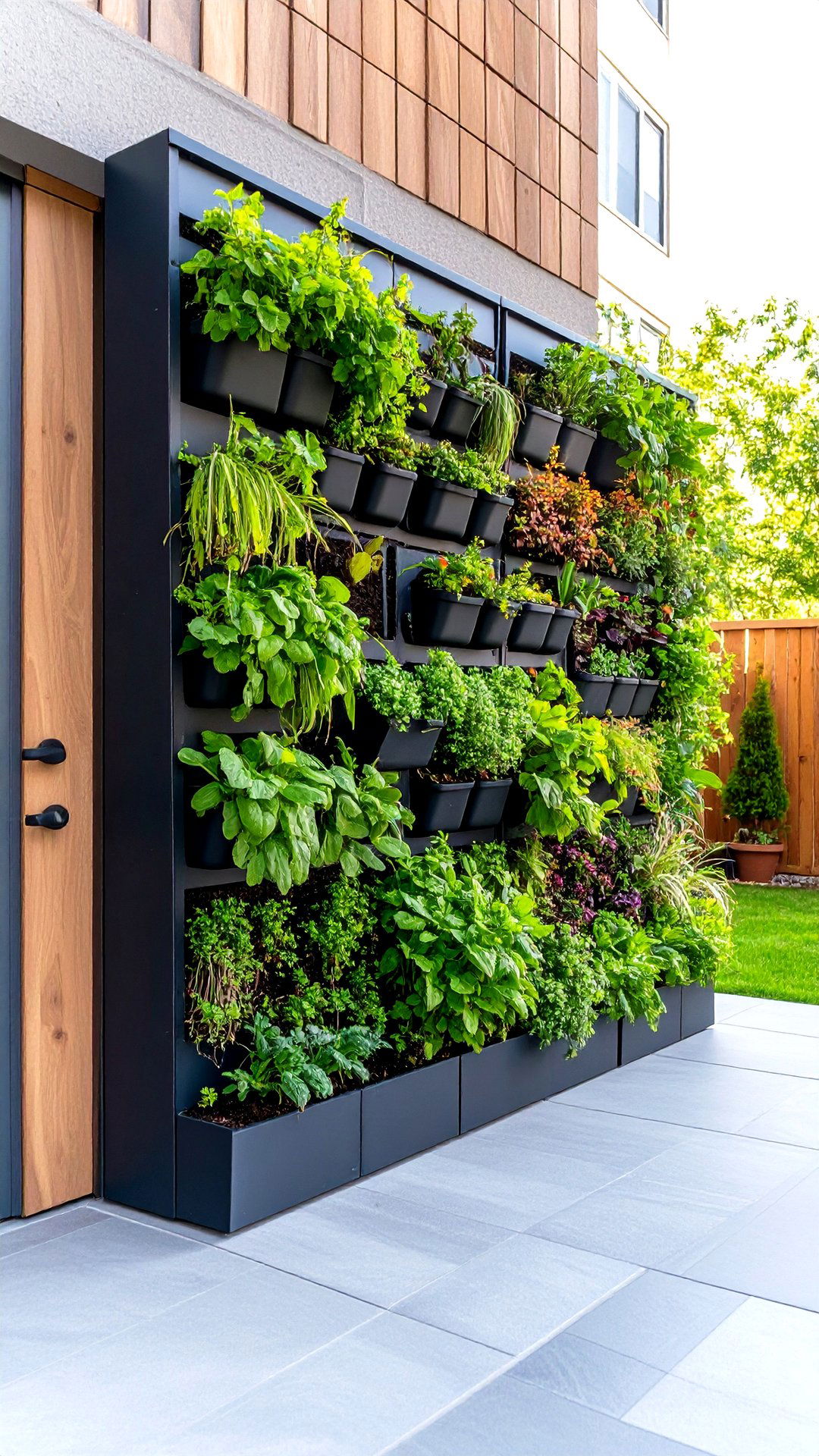
A lush living garden wall instantly transforms a tight patio into a vertical oasis, packing dozens of plants where ground space is scarce. Modular pocket panels or pre-planted trays make installation straightforward; just be sure to add a drip line and occasional liquid feed to keep the root zone moist. Greenleaf’s maintenance guide notes that trimming trailing growth every few weeks prevents shading and encourages bushier coverage, while an annual nutrient boost revives tired sections. For renters, lightweight felt pockets secured to battens let you take the garden wall along when you move.
2. Reclaimed Brick Garden Wall with Vintage Charm
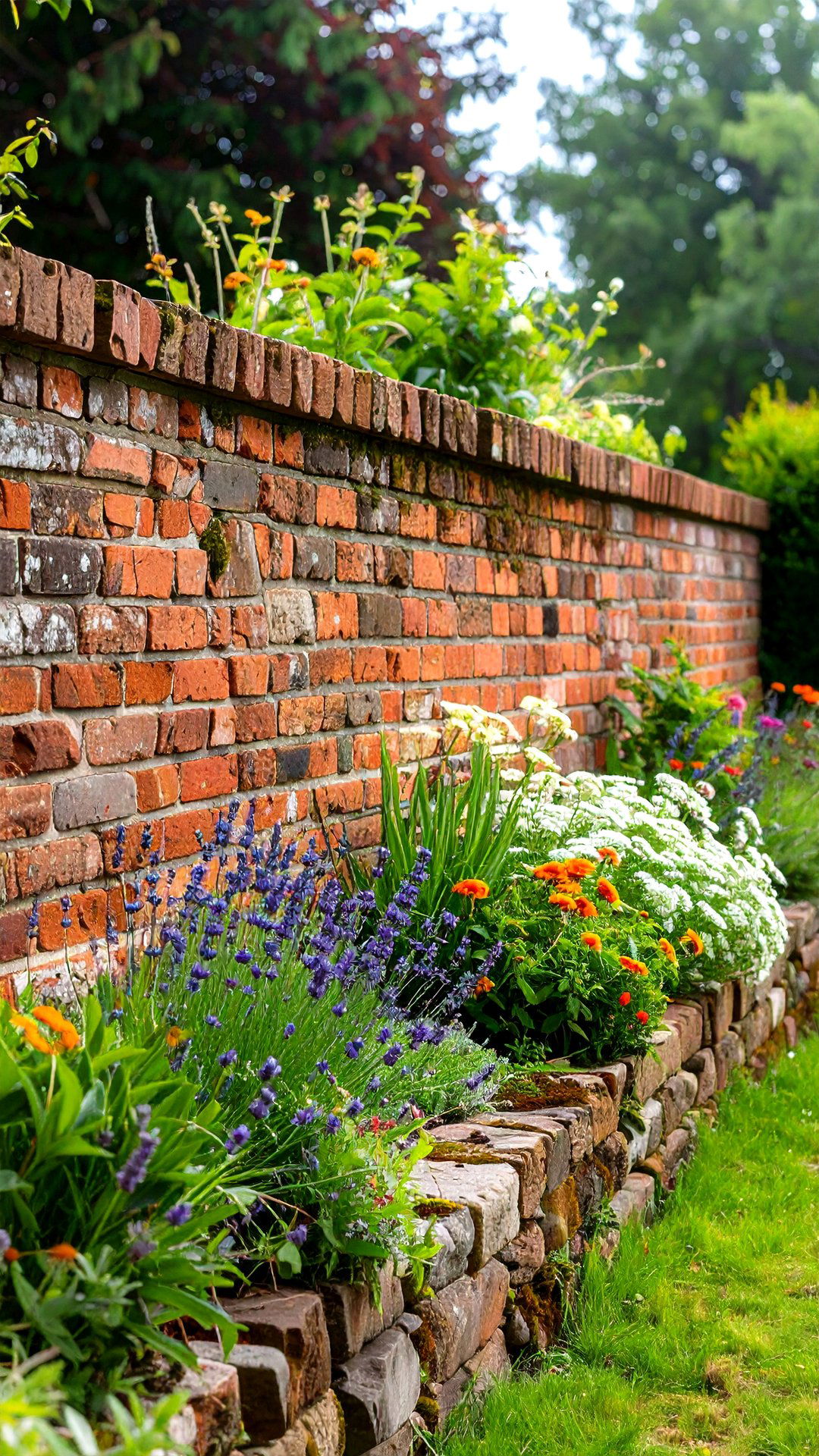
Reclaimed brick adds instant storytelling to a garden wall — think coal dust flecks, hand-pressed textures, and mellowed reds that feel settled from day one. Homes & Gardens highlights how salvaged materials reduce the carbon footprint of new hardscape work while pairing beautifully with cottage planting schemes of lavender, nepeta, and ornamental grasses. Lime-rich mortar allows the wall to “breathe, ” preventing frost damage and letting moss or lichens colonize crevices for extra patina. Cap the top course with reclaimed coping stones so rainwater drips clear of the face and preserves those antique tones.
3. Gabion Garden Wall for Eco-Friendly Texture
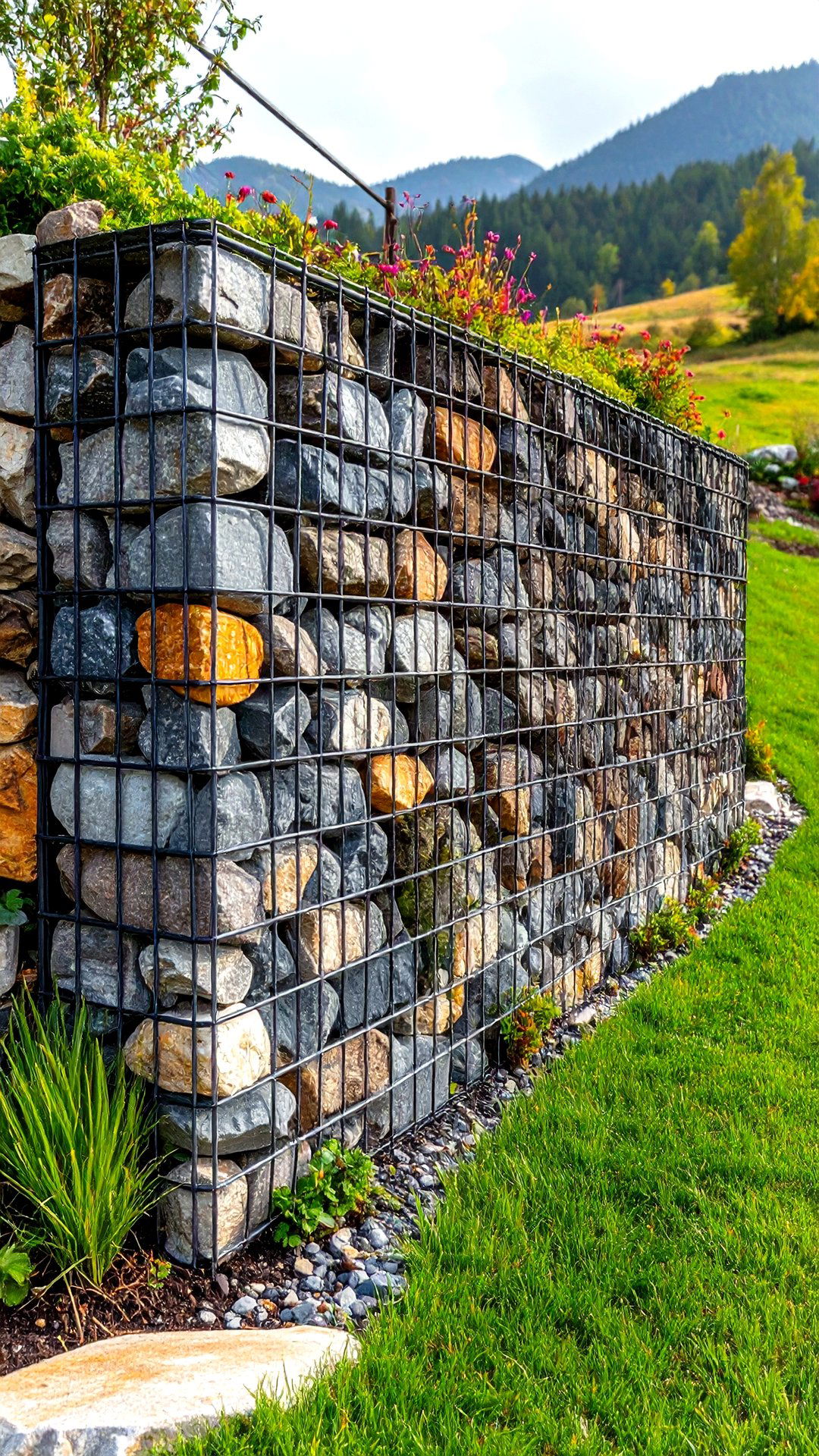
Formed from wire baskets filled with local rock, a gabion garden wall blends rugged looks with impressive sustainability. Gabion Supply explains that stone voids trap airborne pollutants, sequestering carbon long term, and the cages can be refilled or reshaped if your layout changes. Mainland Aggregates adds that porous gaps slow runoff on slopes, curbing erosion without heavy footings. Plant spillers — such as thymus or creeping campanula — root into the crevices, softening the grid and inviting pollinators. Choose galvanized or PVC-coated mesh for longevity and line the back with geotextile to keep soil from migrating.
4. Painted Mural Garden Wall as Outdoor Art
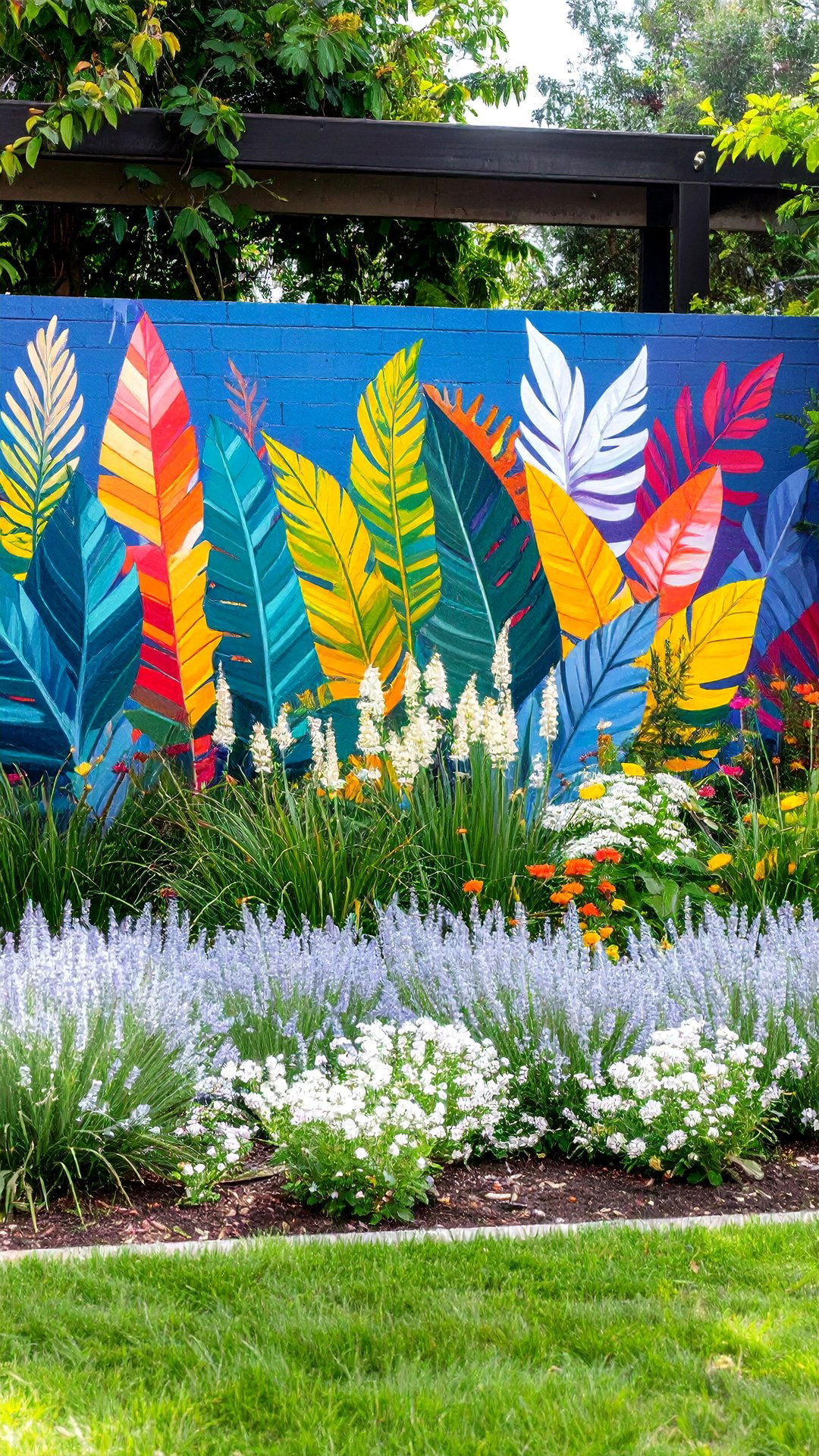
A boldly painted mural turns a plain garden wall into a gallery backdrop, echoing interior color palettes or adding surprise to shaded corners. Pinterest boards of outdoor murals abound with motifs — from tropical leaves to abstract geometrics — that withstand weather if executed in UV-stable masonry paint sealed with a breathable clear coat. Before committing, sketch outlines using chalk or a projector at dusk to test scale. Plant simple monotone beds — silver artemisia, white gaura — so foliage doesn’t compete with the artwork, ensuring the garden wall remains the main visual anchor.
5. Mirror-Clad Garden Wall to Amplify Light
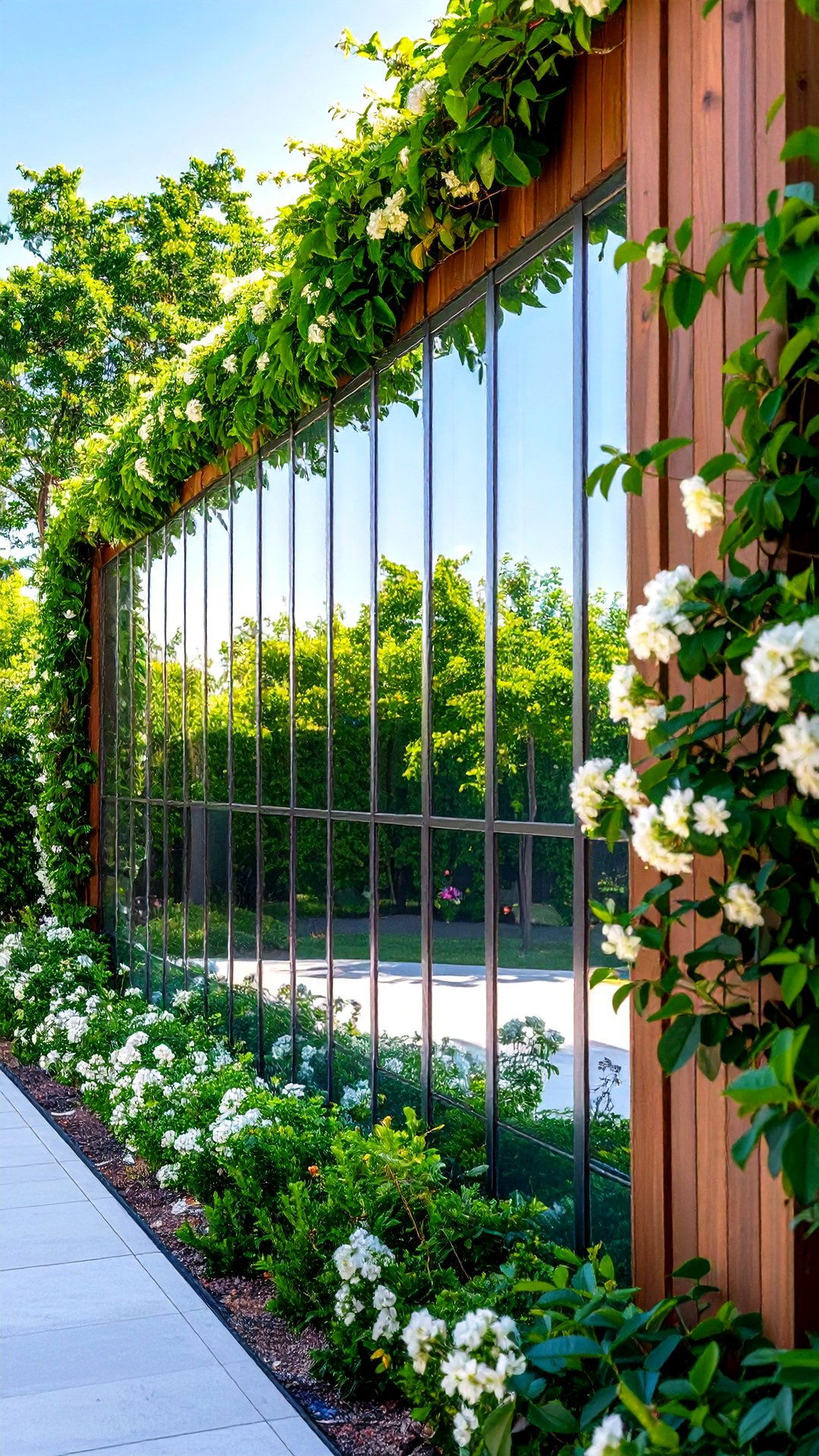
Strategically placing mirrors on a garden wall doubles greenery and pulls sunlight into gloomy city plots. advises fixing shatter-resistant acrylic panels slightly tilted downward so they reflect planting rather than the sky, and positioning them where birds won’t mistake the image for open flight. Framing each panel in timber or metal echoes window mullions, creating an illusion of hidden rooms beyond. Always leave expansion gaps for temperature swings and use exterior-grade adhesive plus concealed screws for safety. A mirror garden wall pairs beautifully with fragrant climbers like jasmine for a multisensory surprise.
6. Vertical Herb Garden Wall for Fresh Flavors
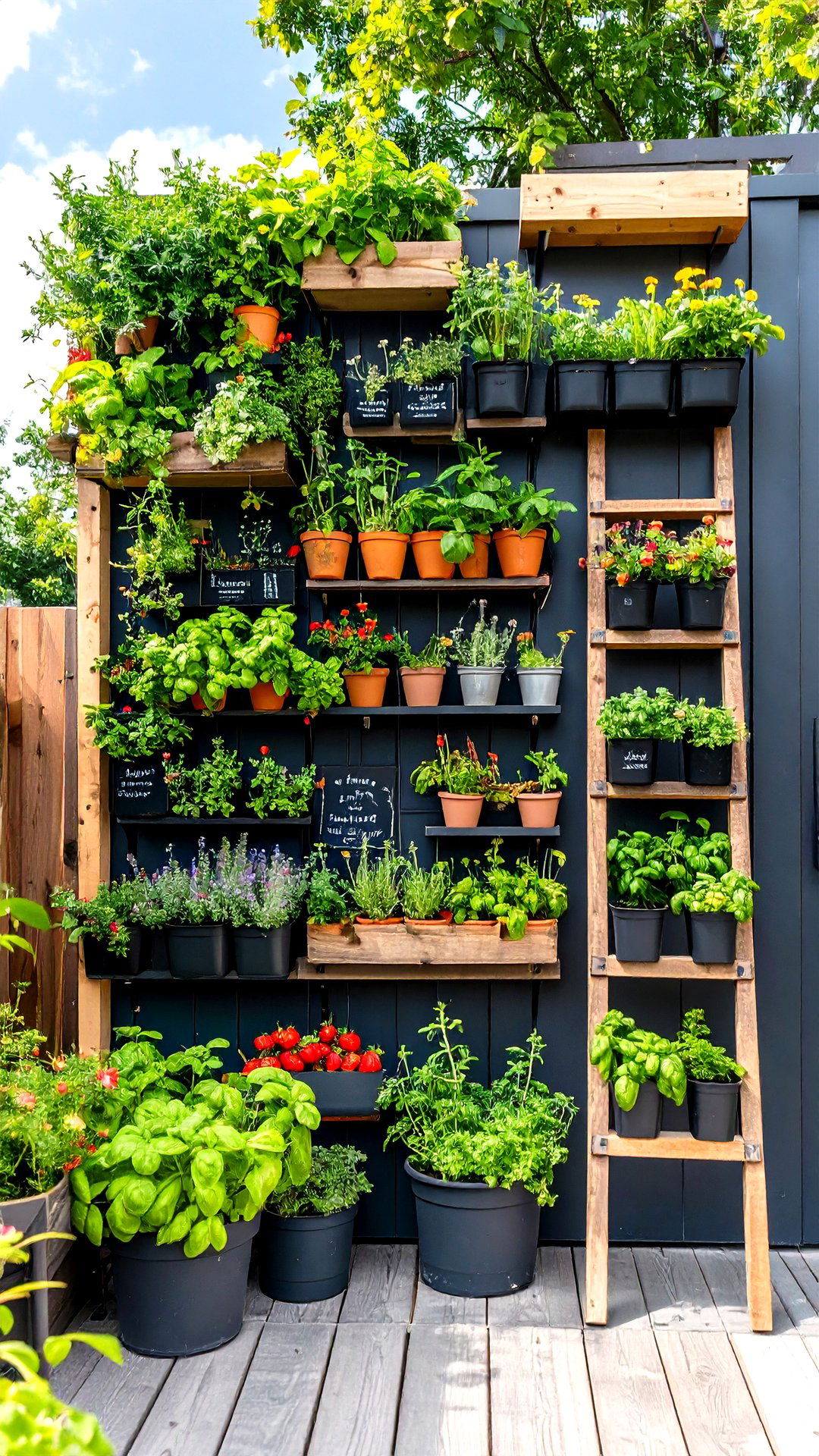
Nothing beats snipping oregano at arm’s reach from the barbecue, and a vertical herb garden wall delivers kitchen staples without hogging patio floor. BBC Gardeners’ World lists pocket planters, gutter runs, or ladder shelves as efficient supports for thyme, parsley, and strawberries. Mount the structure on a sunny, south-facing wall near your cooking zone and add a timer-controlled drip line to prevent drying. Rotate annual herbs seasonally — basil in summer, coriander in cooler months — to keep the garden wall productive year-round, and label pockets with chalk paint for quick harvests.
7. Modern Concrete Garden Wall with Clean Lines
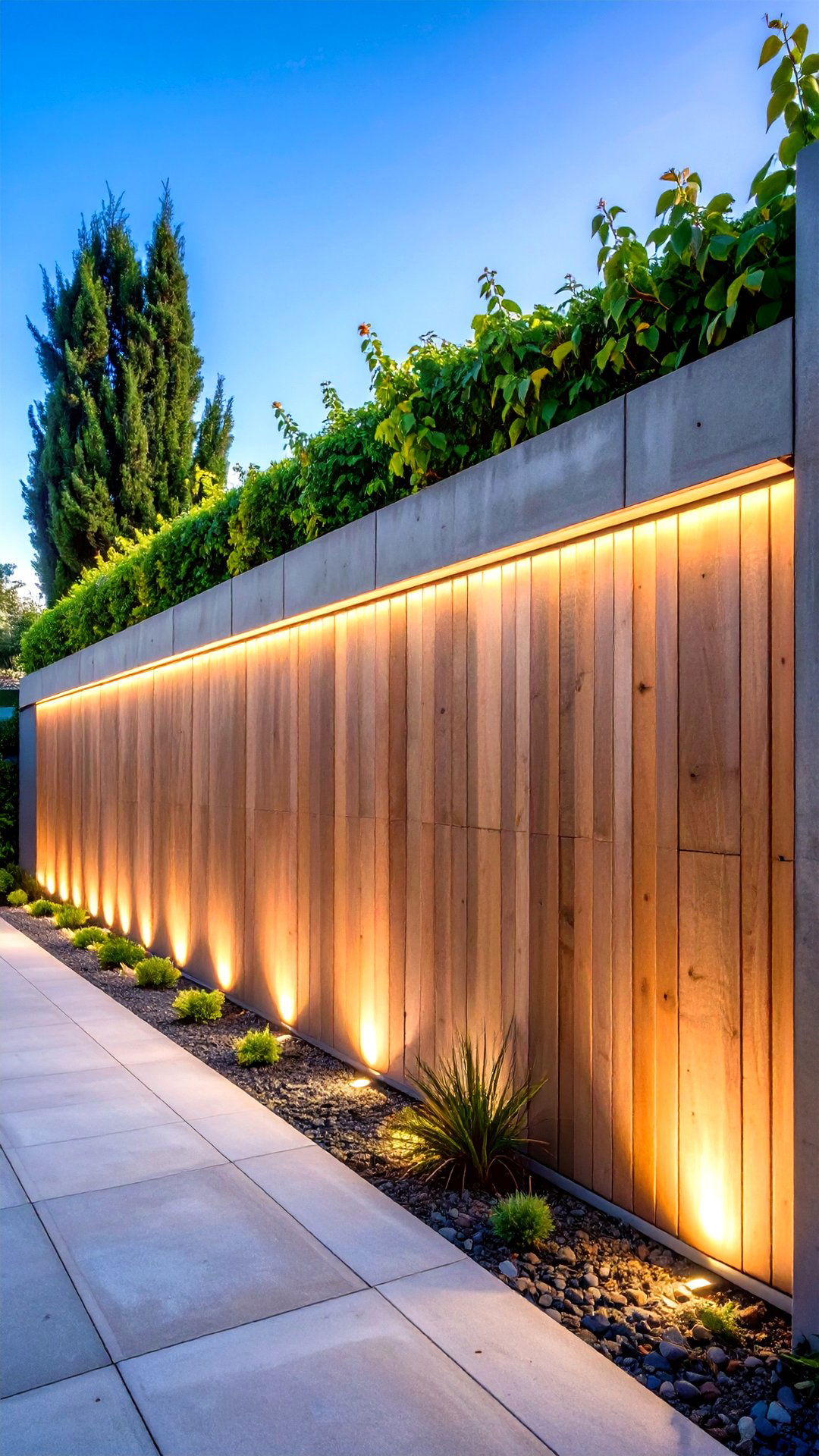
Prefinished concrete panels or poured-in-place walls bring contemporary flair, complementing minimalist decks and steel planters. This Old House notes concrete’s unmatched compressive strength, making it ideal for retaining soil on terraced sites while resisting rot and pests. Integrate narrow shadow gaps or inset LED strips to accentuate crisp joints after dark. If raw gray feels stark, tint the mix with iron oxide pigments or add board-form impressions for subtle texture. Climbing figs soften the surface over time yet won’t undermine structural integrity thanks to their non-invasive roots.
8. Timber Slatted Garden Wall for Privacy
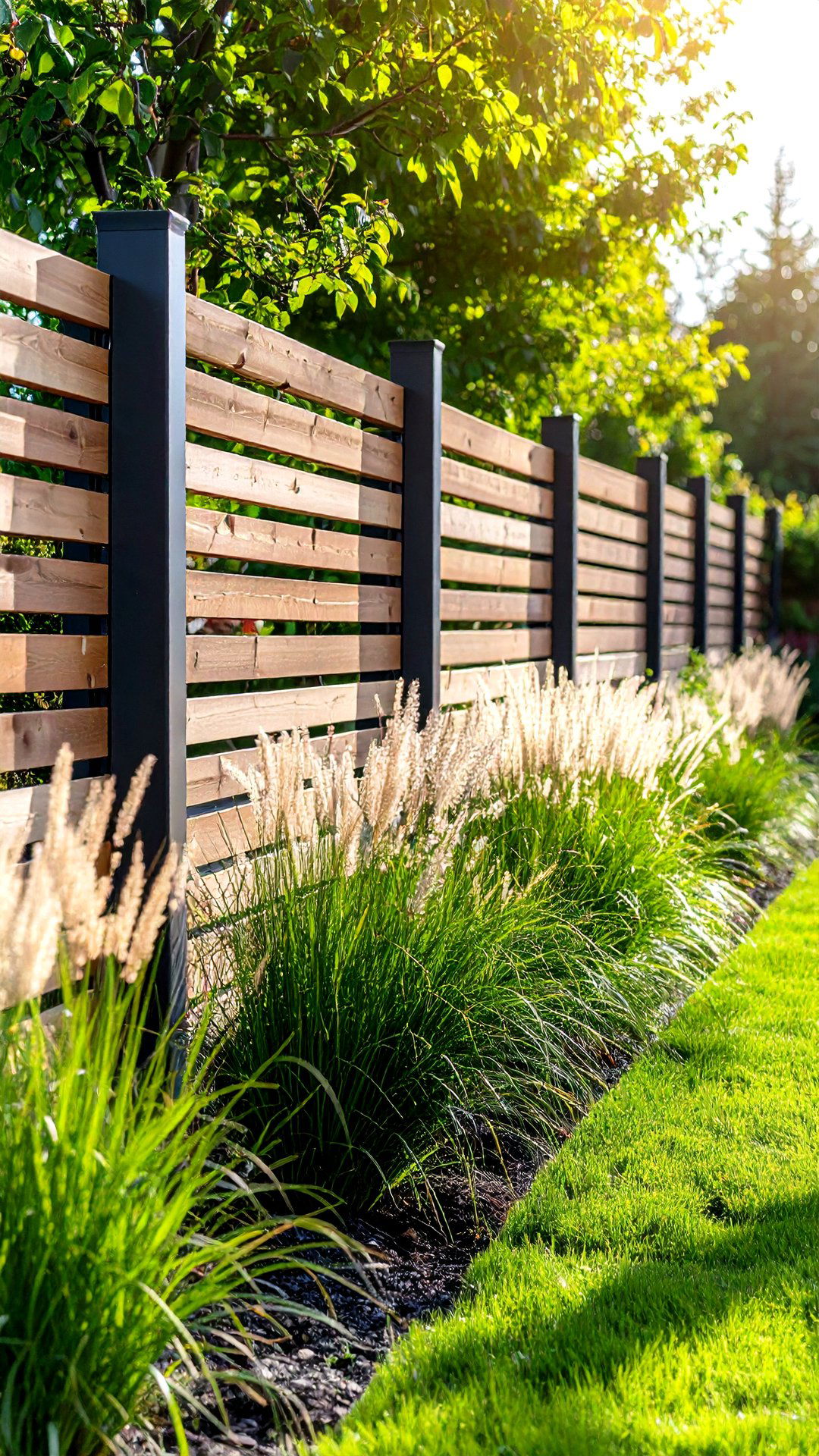
Horizontal timber slats give a garden wall airy seclusion, screening neighbors while letting breezes and dappled light pass. Houzz galleries show cedar or thermally modified pine battens fixed on powder-coated steel posts for a clean, architectural rhythm. Adjusting slat spacing from 10 mm to 25 mm tailors sightlines — tight around hot tubs, wider beside lawns. Treat boards annually with penetrating oil to slow silvering, or embrace the gradual drift to gray for a coastal vibe. Layer tall ornamental grasses in front so plumes sway through the slots for kinetic interest.
9. Stone Retaining Garden Wall That Doubles as Seating
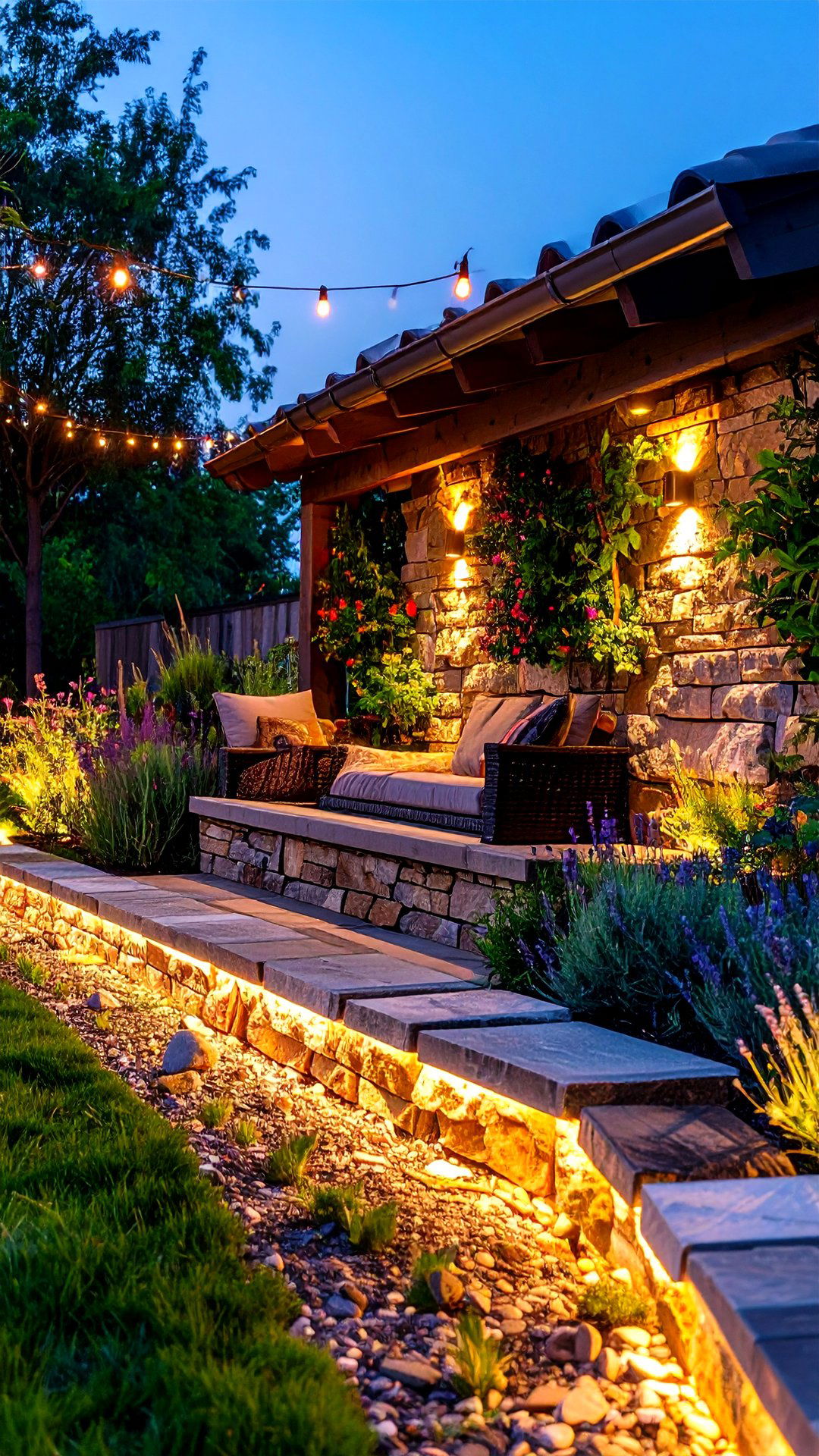
A low dry-laid stone garden wall can both hold back earth and offer an impromptu bench along paths. Lawn Care Plus ranks stone among the most durable retaining materials, particularly where drainage weeps between joints, relieving hydrostatic pressure. A 450 mm-wide coping cap at seat height (around 450 mm) invites guests to perch, and adding recesses for LED strip lights under the cap ensures safe night steps. Plant trailing rosemary or campanula in wall crevices so aromas release as legs brush the foliage during a garden stroll.
10. Corten Steel Garden Wall for Industrial Warmth
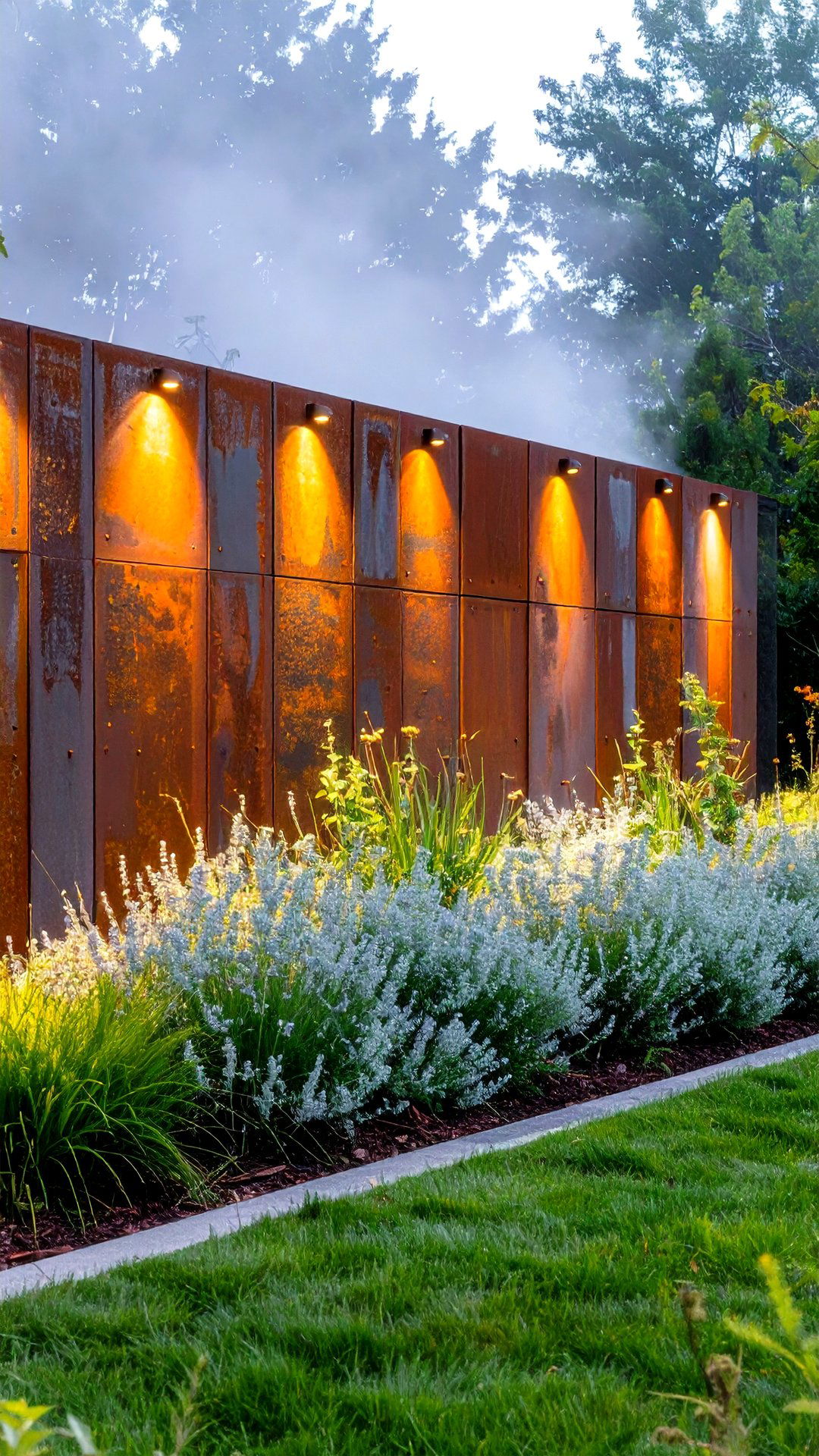
Weathering steel garden walls shift from orange to rich umber, offering drama without maintenance. Garden Design explains that corten’s rust-like patina forms a protective skin, so it rarely needs sealing. For variety, Container Water Gardens showcases corten used as raised beds and privacy screens, proving its versatility across heights. Anchor panels to concrete footings to avoid staining adjacent paving, and tuck uplights at the base to glow through evening mist. A corten garden wall pairs beautifully with silvery foliage — think artemisia or olive — creating a sophisticated tonal palette.
11. Stucco Garden Wall with Mediterranean Feel
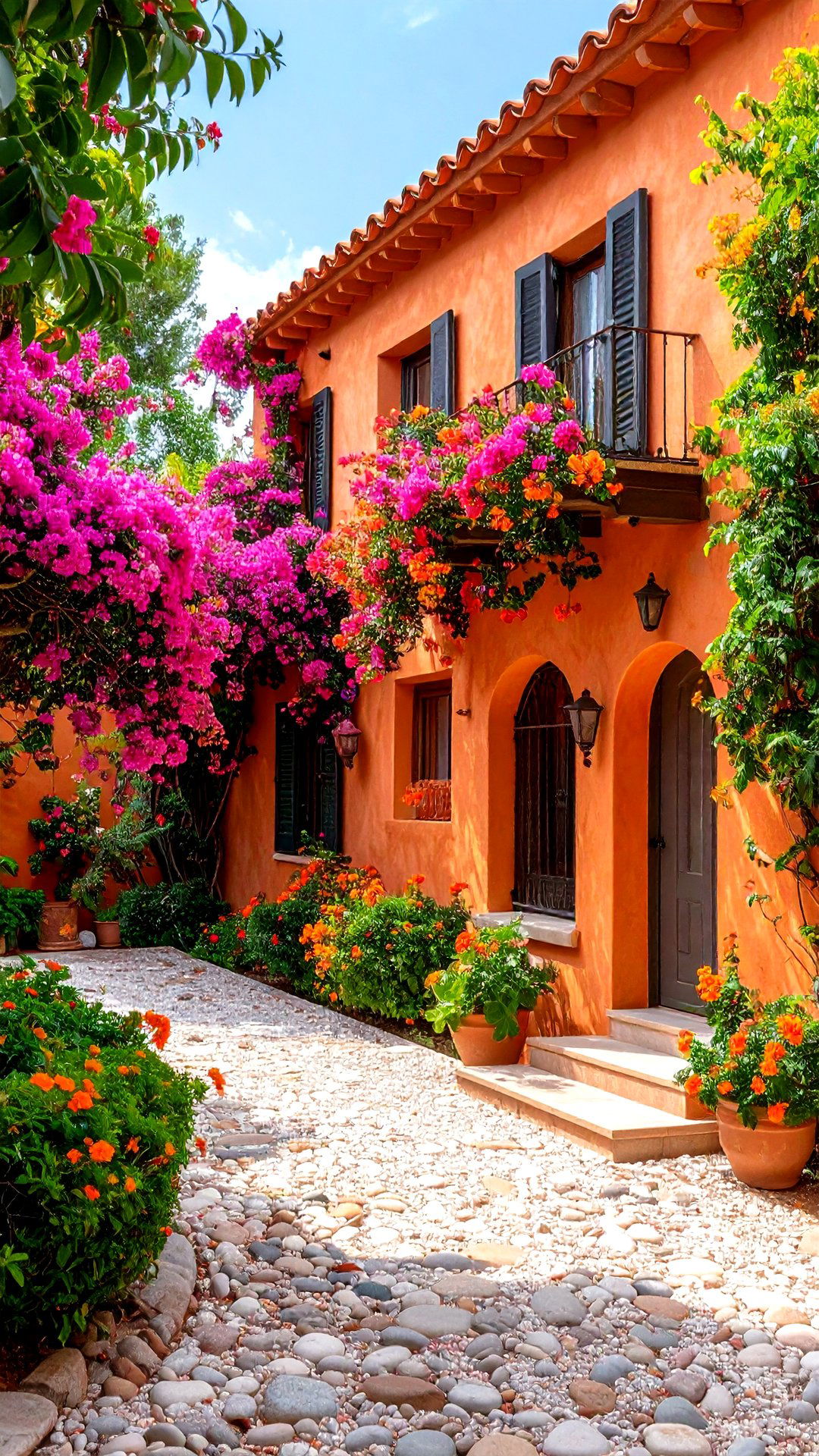
Stucco garden walls evoke sun-washed courtyards and pair effortlessly with terracotta pots and bougainvillea. Houzz’s Mediterranean exteriors highlight warm, textured finishes that bounce light and mask minor hairline cracks better than paint alone. The Stucco Guy notes lime-based renders remain breathable, vital in humid climates, while iron-oxide pigments tint walls in ochre, blush, or sand without risk of peeling. Embed terracotta coping tiles to shed rain and echo rooflines, then finish the base with river cobbles to reduce splash-back stains and ground the wall visually.
12. Pallet Planter Garden Wall as Budget DIY
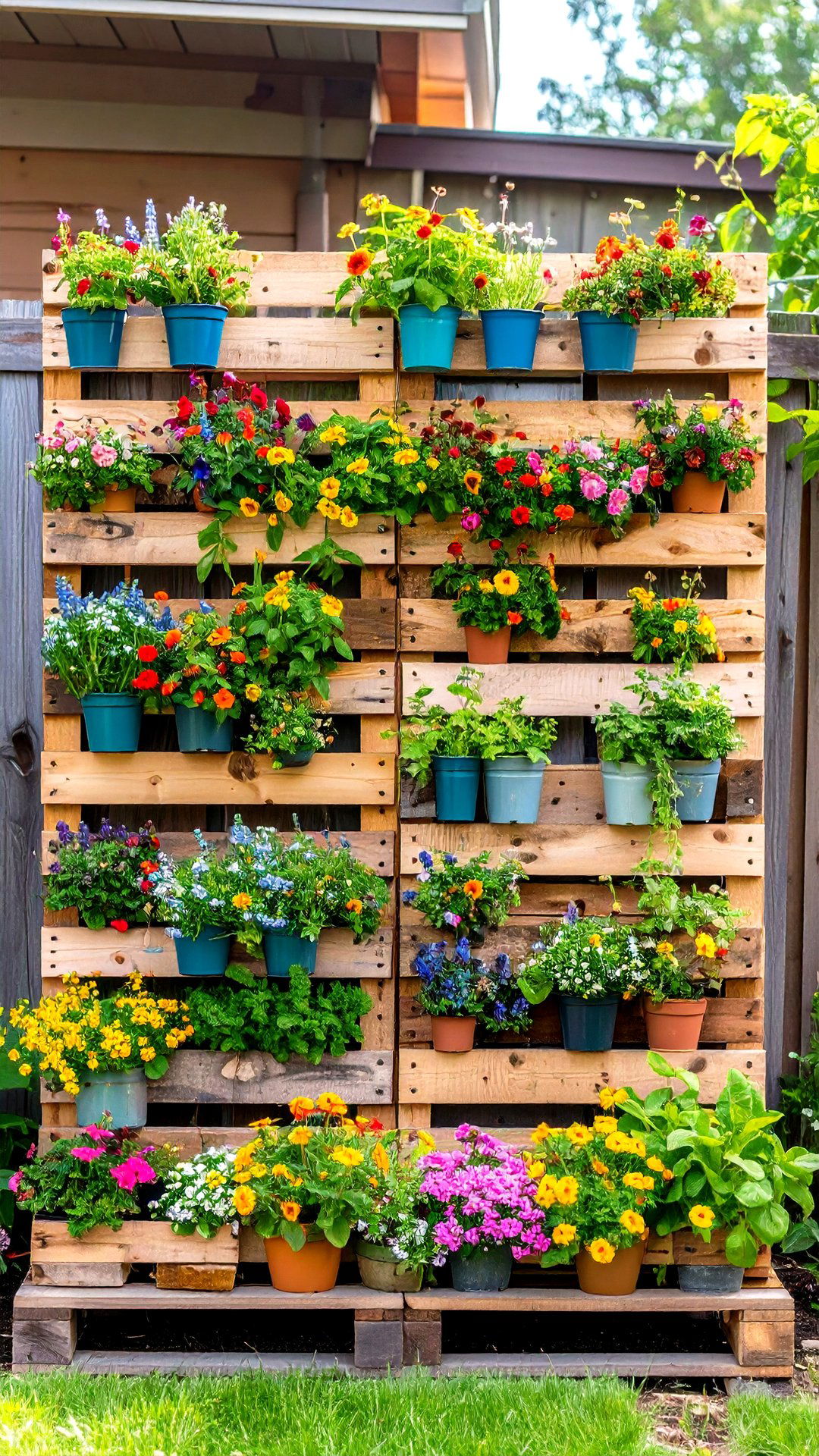
Repurposed shipping pallets can become a rustic garden wall brimming with herbs or annuals for the price of screws and stain. The Shady Gal tutorial walks through attaching upright pallets to 4×4 posts, backing them with landscape fabric, then filling pockets with lightweight potting mix. Stain or char the timber to extend its life, and rotate plantings seasonally — pansies in winter, nasturtiums come spring. Because pallets aren’t structural, limit wall height to about 1. 8 m and brace corners with galvanized brackets. The result is a playful, upcycled garden wall that sparks conversation.
13. Garden Wall with Built-In Water Feature

Adding a spillway blade or rill down a garden wall layers soothing sound over visual appeal. Homes & Gardens’ broader garden ideas list recommend siting water features where they can be seen from indoors, effectively extending the living room view. Use impermeable liner behind stone or rendered finishes, and include a removable stainless-steel mesh to catch leaves before they clog the pump. Adjustable flow controllers let you fine-tune splash volume — trickling for calm meditation corners or gushing for urban noise masking. Lighting the cascade from below turns the wall into a night-time focal point.
14. Light-Washed Garden Wall Using Sconces
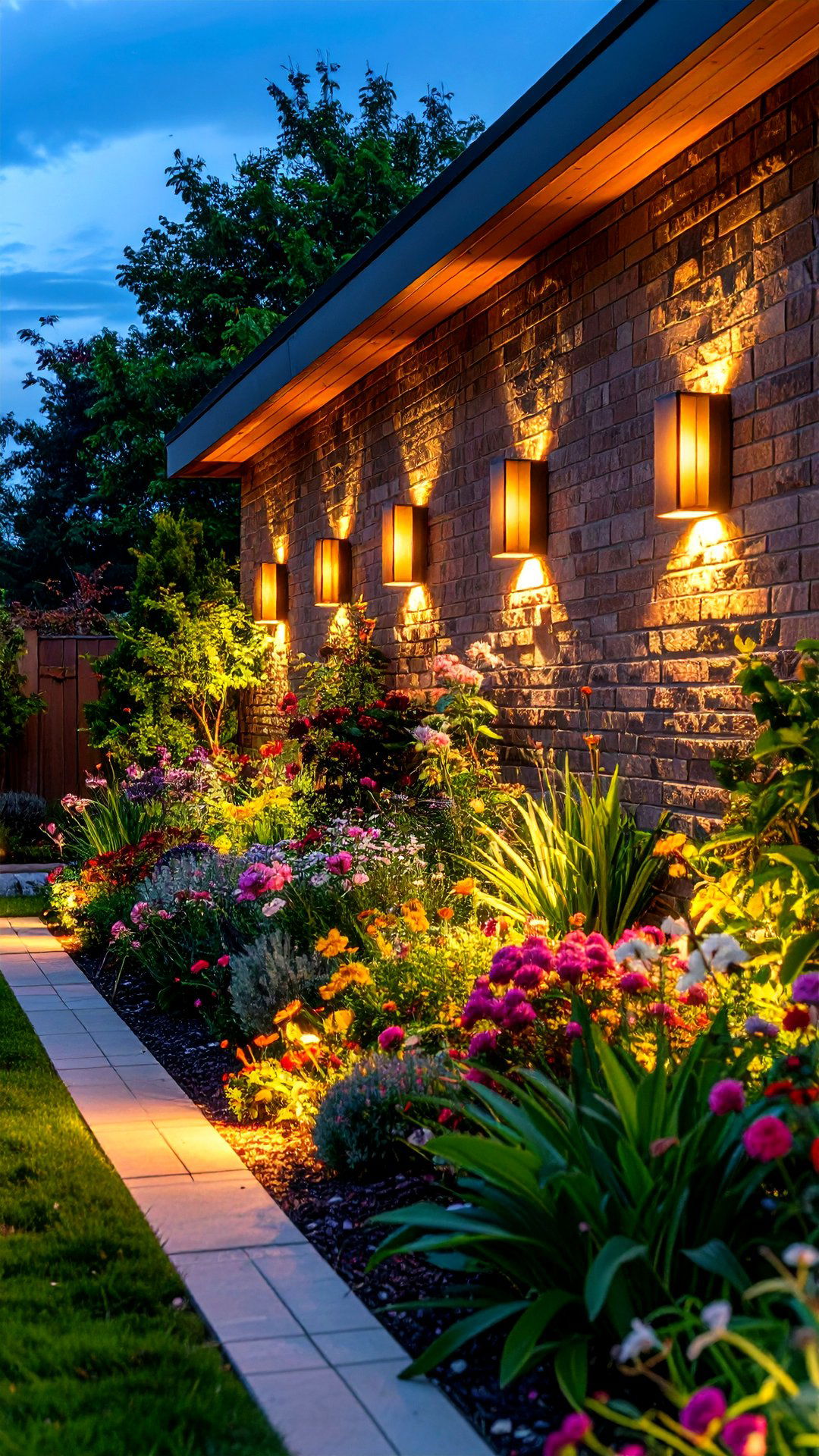
Outdoor-rated sconces fixed to a garden wall add layers of ambience and boost security after sunset. Lamps. com’s range shows why downward-facing fixtures with warm LEDs limit glare while highlighting textures like brick or timber. Space fittings roughly every 2 – 2. 5 m for even coverage, wiring through concealed conduit chased into mortar joints. Select finishes that echo other metal accents — galvanized for coastal, matte black for contemporary. Pair dimmable transformers with smart home hubs so you can set “dinner, ” “party, ” or “pathway” scenes, proving that a garden wall can earn its keep around the clock.
15. Garden Wall with Climbing Roses and Trellis
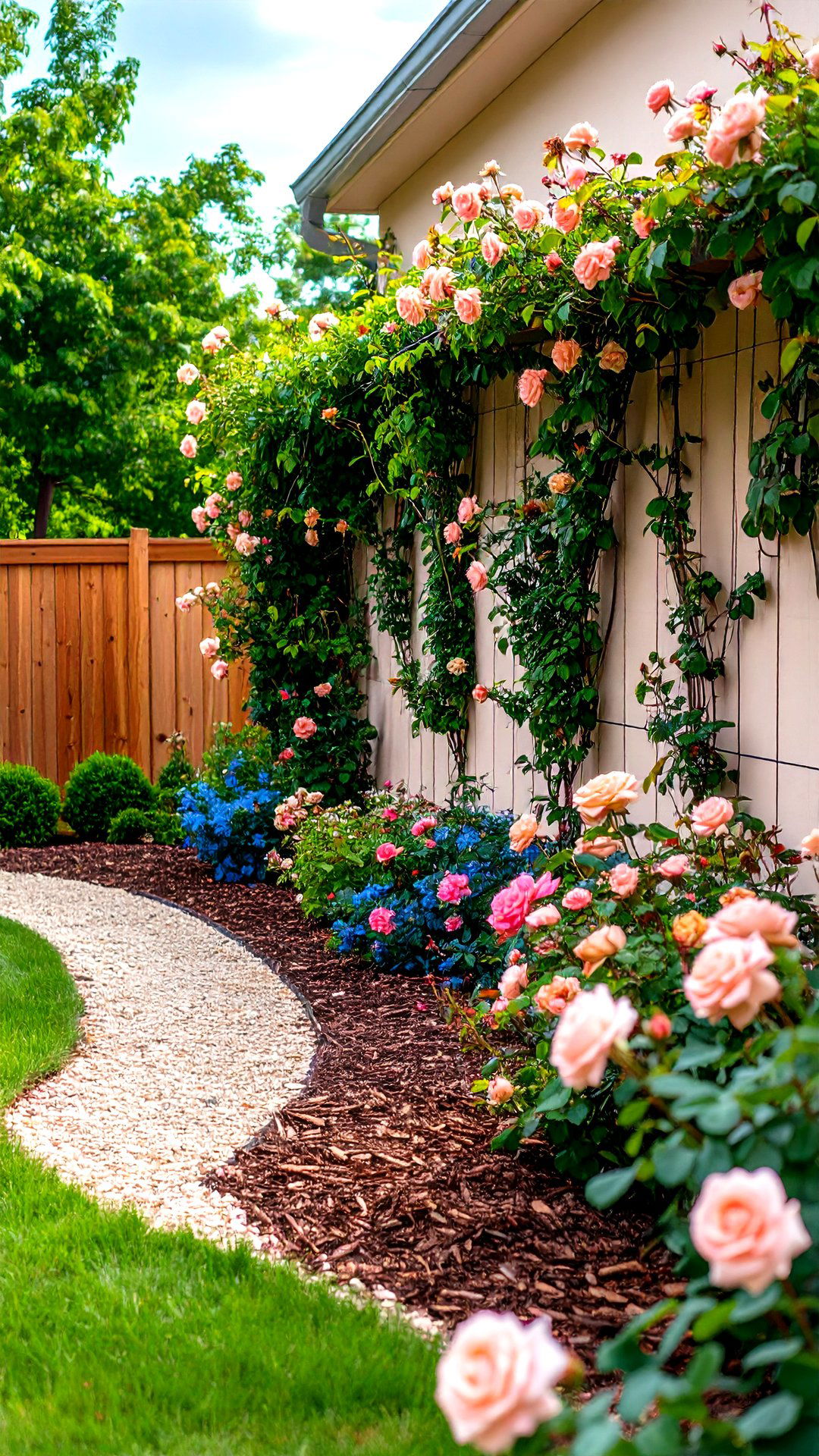
Few sights beat a garden wall draped in scented roses mid-June. Gardeners’ World recommends fan-training vigorous varieties like ‘Claire Austin’ or ‘New Dawn’ across tensioned wires 45 cm apart, allowing good airflow to deter black spot. Tie new canes horizontally to promote flowering laterals and mulch heavily at the base to conserve moisture. Adding clematis with complementary bloom times extends color into late summer — just ensure pruning groups align. Paint the wall a pale hue beforehand; the subtle backdrop makes blossoms pop and visually widens narrow side yards.
16. Mixed-Height Planting in Front of Garden Wall
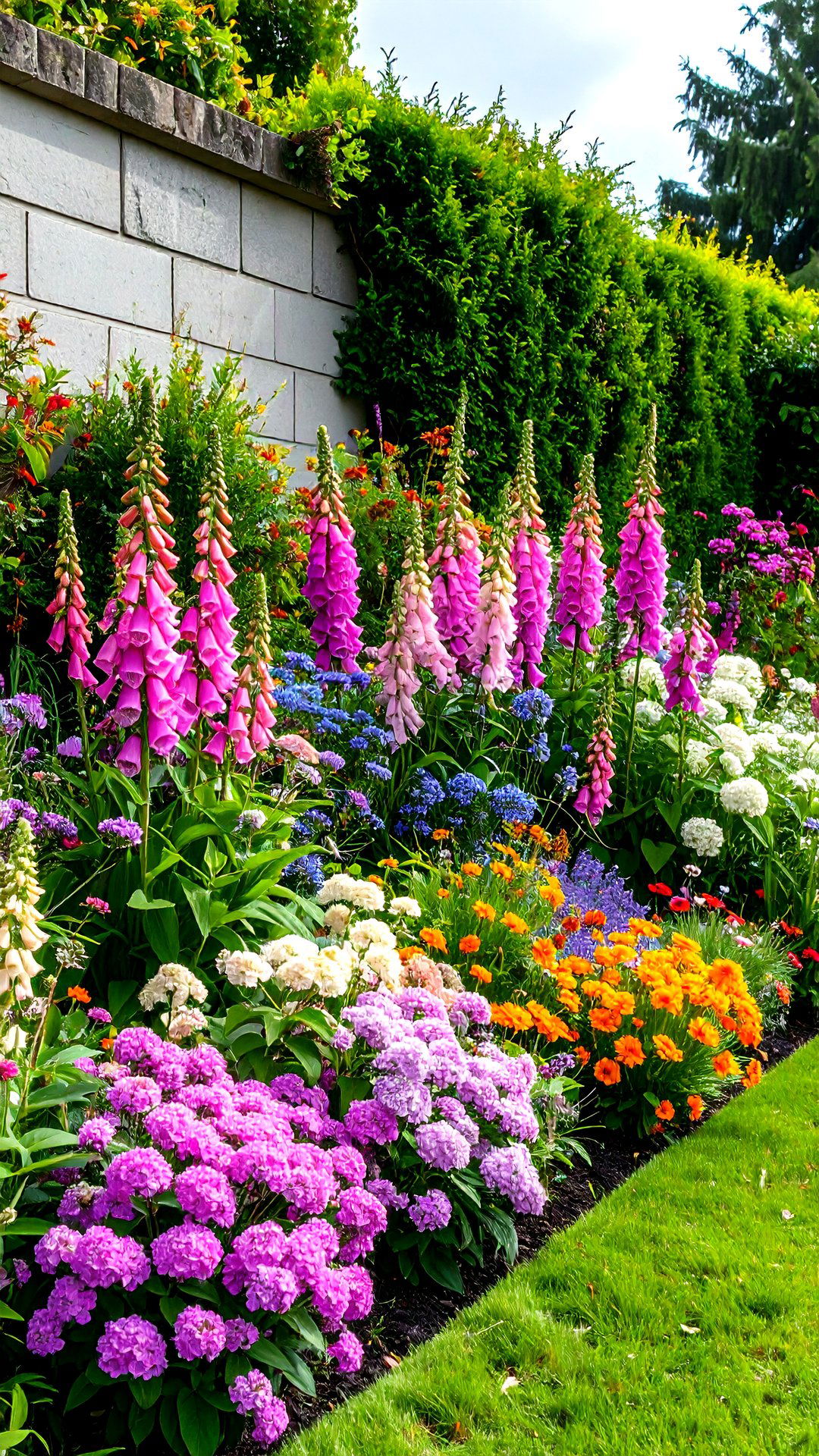
Layering shrubs and perennials of varied heights in front of a garden wall blurs hard edges and deepens perspective. Homes & Gardens’ wall ideas article notes that combining a low evergreen hedge with mid-storey hydrangeas allows the vertical plane to peek between blooms for contrast. Use taller accents — such as foxgloves or verbascum — occasionally so the eye rises above the wall, preventing a claustrophobic feel. Mulch with composted bark to unify the scheme and cut weeding chores. The interplay of solid wall and soft planting makes every season’s shift more dramatic.
17. Tiered Garden Wall Terraces on a Slope
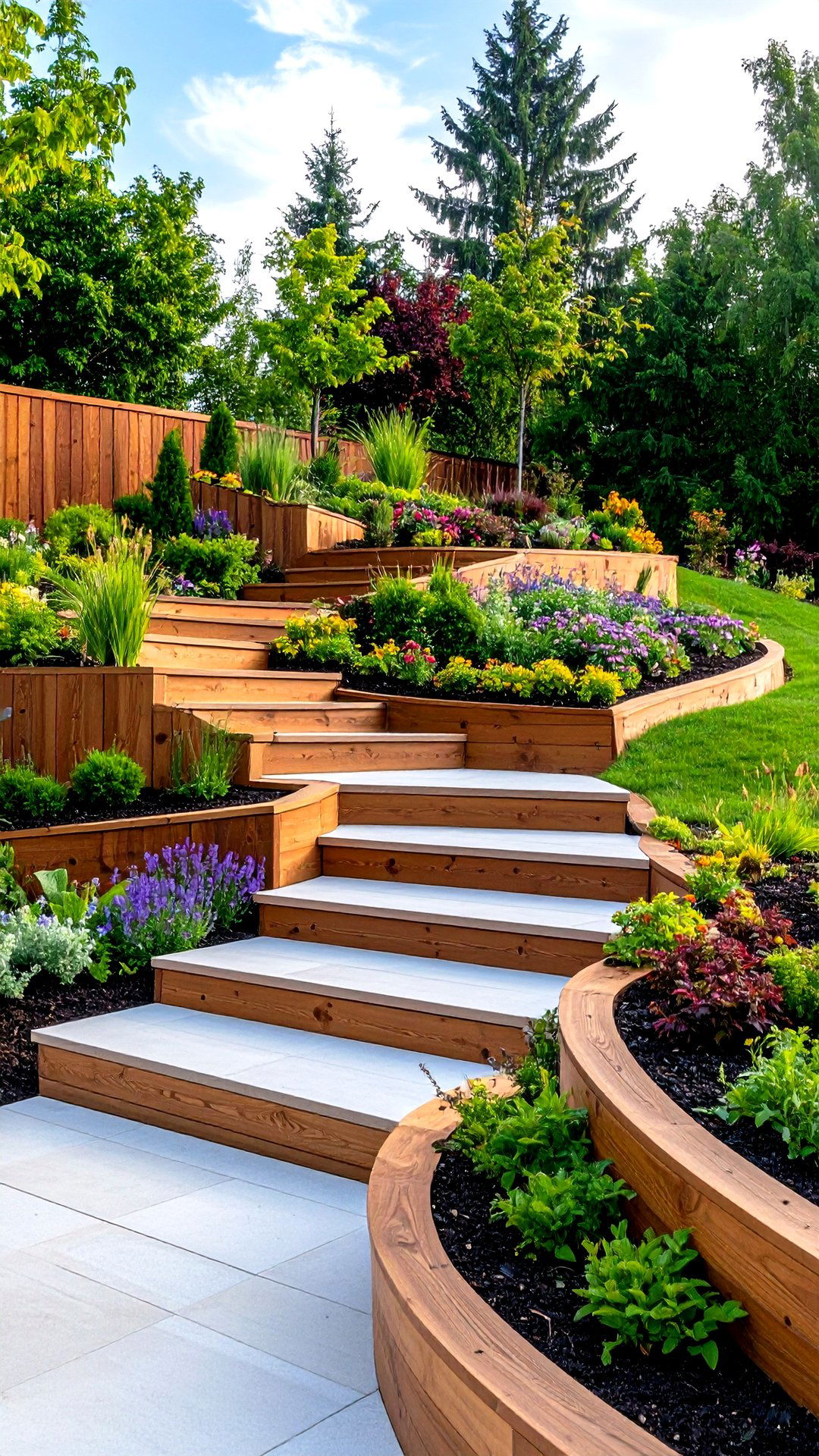
On steep plots, series of low terraces outperform one high retaining garden wall by easing load, offering planting ledges, and creating walkable steps. This Old House details that timber, concrete blocks, or interlocking units all suit tiering, depending on budget and aesthetics. Staggered beds let you experiment with microclimates — sun-baked herbs above, moisture-loving ferns below — while integrated steps ensure smooth circulation. Drainage gravel behind each riser is non-negotiable to prevent pressure buildup, and geogrid fabric can reinforce soil on taller lifts without detracting from planting depth.
18. Succulent Pocket Garden Wall for Drought Areas
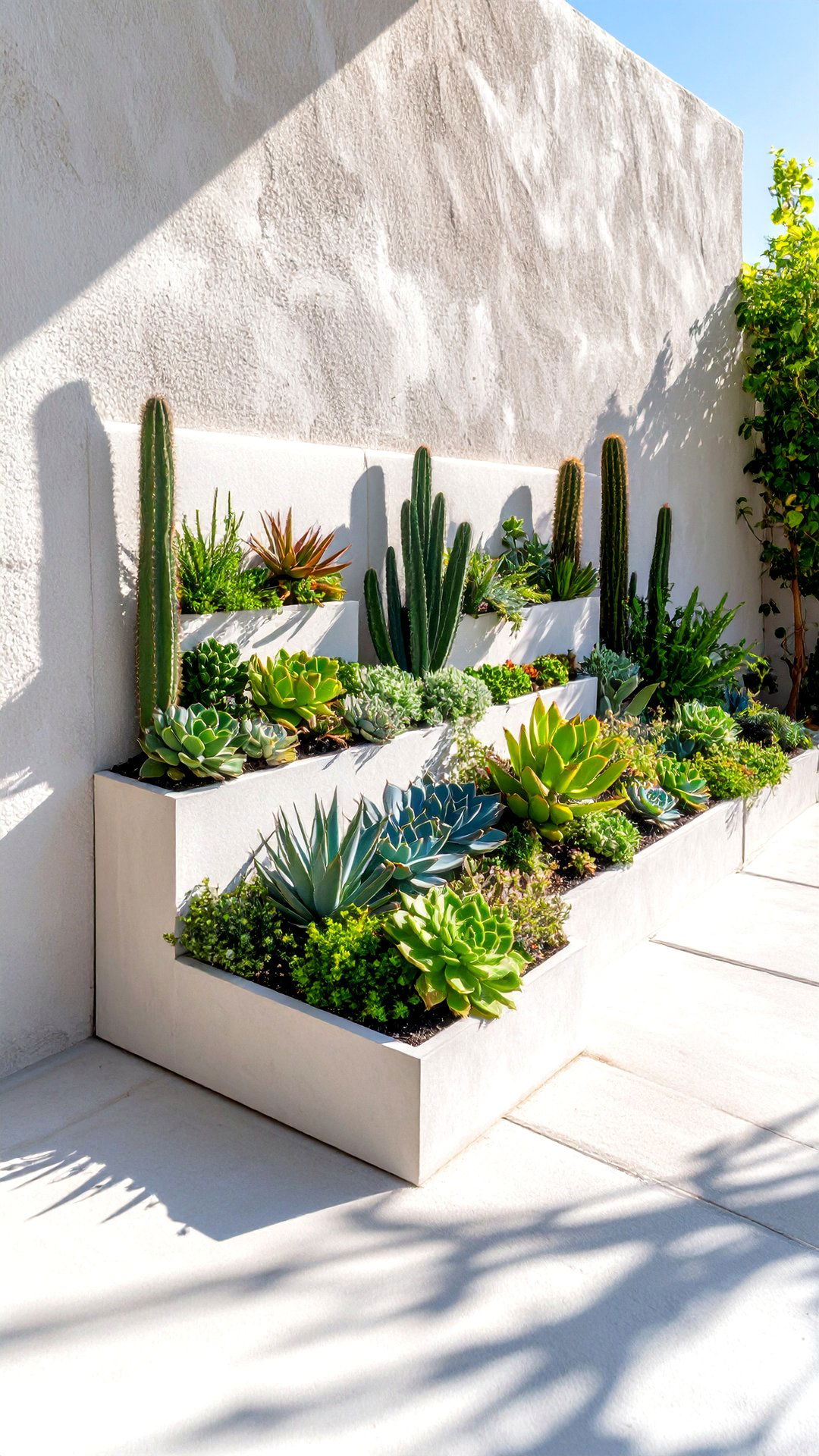
In arid climates, a succulent-stuffed garden wall saves water yet bursts with sculptural form. Gardeners’ World’s vertical ideas list cites felt pockets as perfect for shallow-rooted sedums and echeverias, provided drainage holes prevent rot after rare downpours. Mix colors — blue chalk sticks, burgundy aeoniums — and textures for a tapestry effect, and sprinkle slow-release cactus fertilizer sparingly each spring. Mount the panel on spacers so air circulates behind, cooling roots. A succulent garden wall needs little more than a monthly mist, making it ideal for vacation homes or forgetful gardeners.
19. Garden Wall with Integrated Birdhouses and Habitat
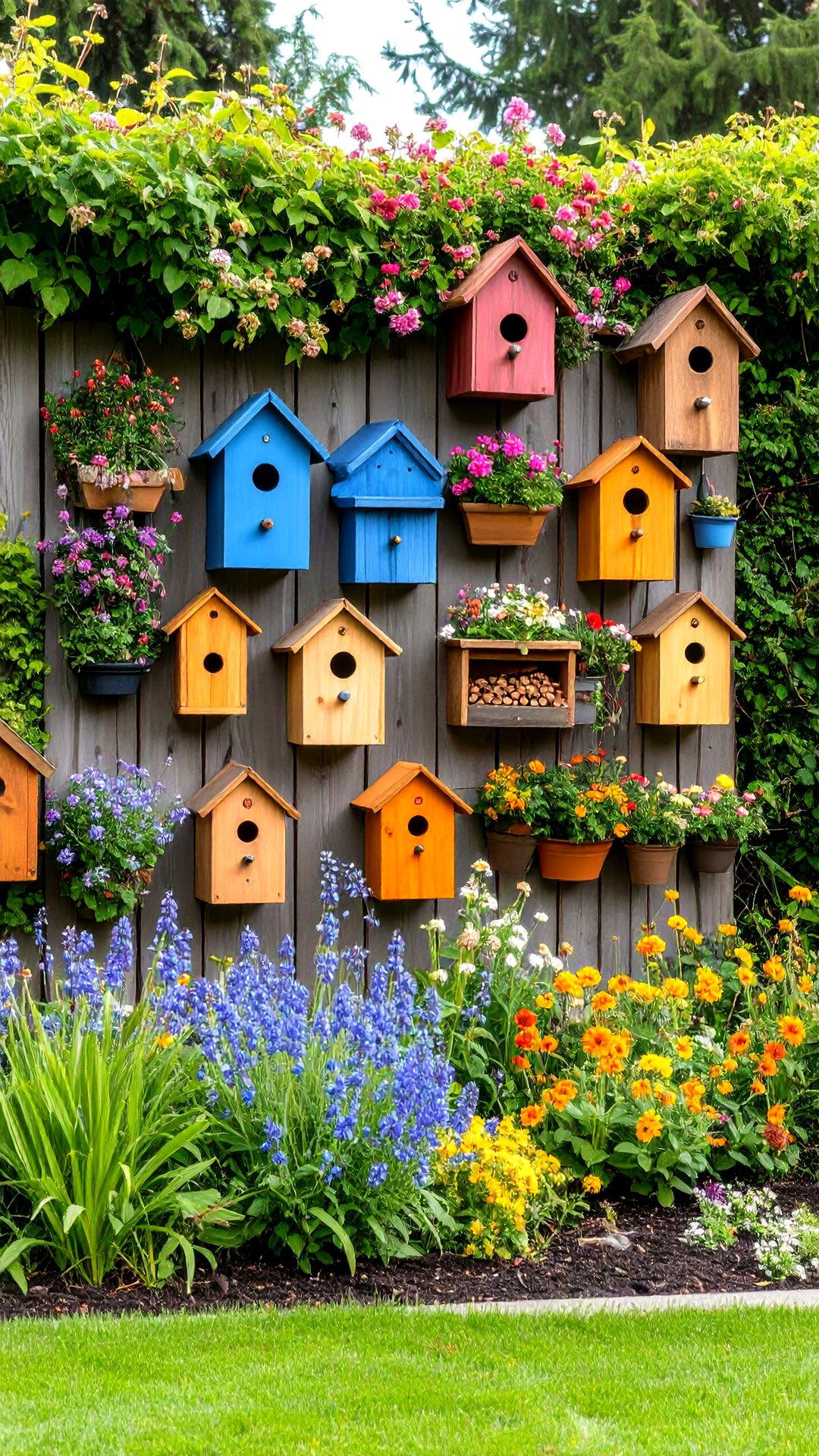
Turning a garden wall into wildlife real estate benefits local ecosystems while delighting kids. Homes & Gardens suggests embedding timber bird boxes or insect hotels flush with the surface so predators can’t perch. Choose untreated hardwood and drill drainage holes to prevent soggy nests. Plant nectar-rich climbers like honeysuckle to nourish pollinators using embedded bee bricks. Add a shallow water dish on a bracket for drinking and bathing; keeping it cat-proof elevates success rates. Your garden wall then serves both as boundary and biodiversity booster.
20. Glass Block Garden Wall for Translucent Screening
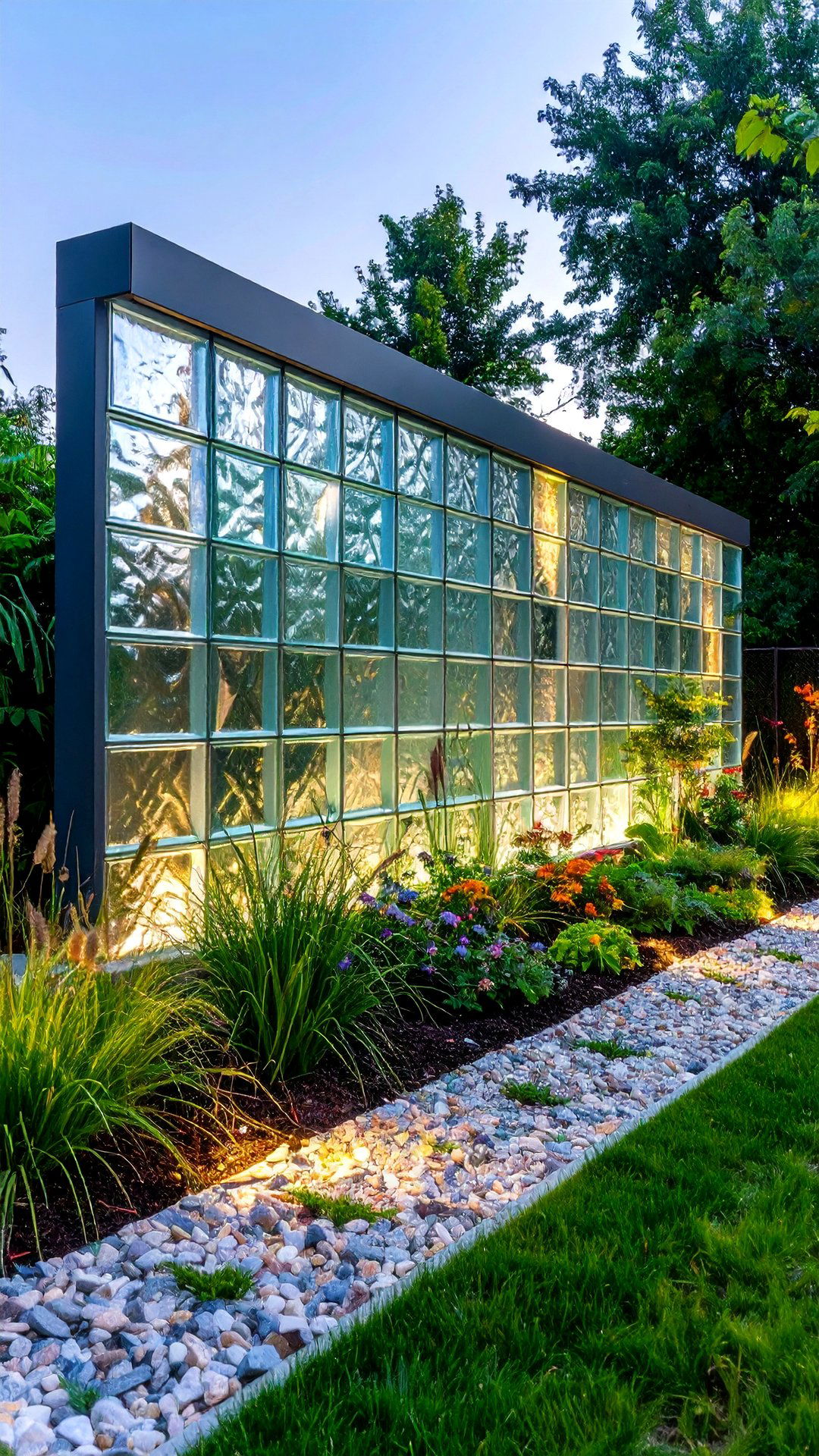
A garden wall built from glass blocks filters light while blurring sightlines — ideal beside an outdoor shower or hot tub. Houzz examples show blocks mortared onto reinforced concrete footings and capped with powder-coated aluminum. Frosted or wavy textures obscure shapes yet glow at night when backlit by waterproof LED strips. Ensure drainage weep holes at the base, and include stainless steel reinforcement bars every second course for safety. Pair sleek blocks with gravel and grasses for a spa-like minimalism that still whispers “private. ”
21. Mosaic Tile Garden Wall for Color Splash
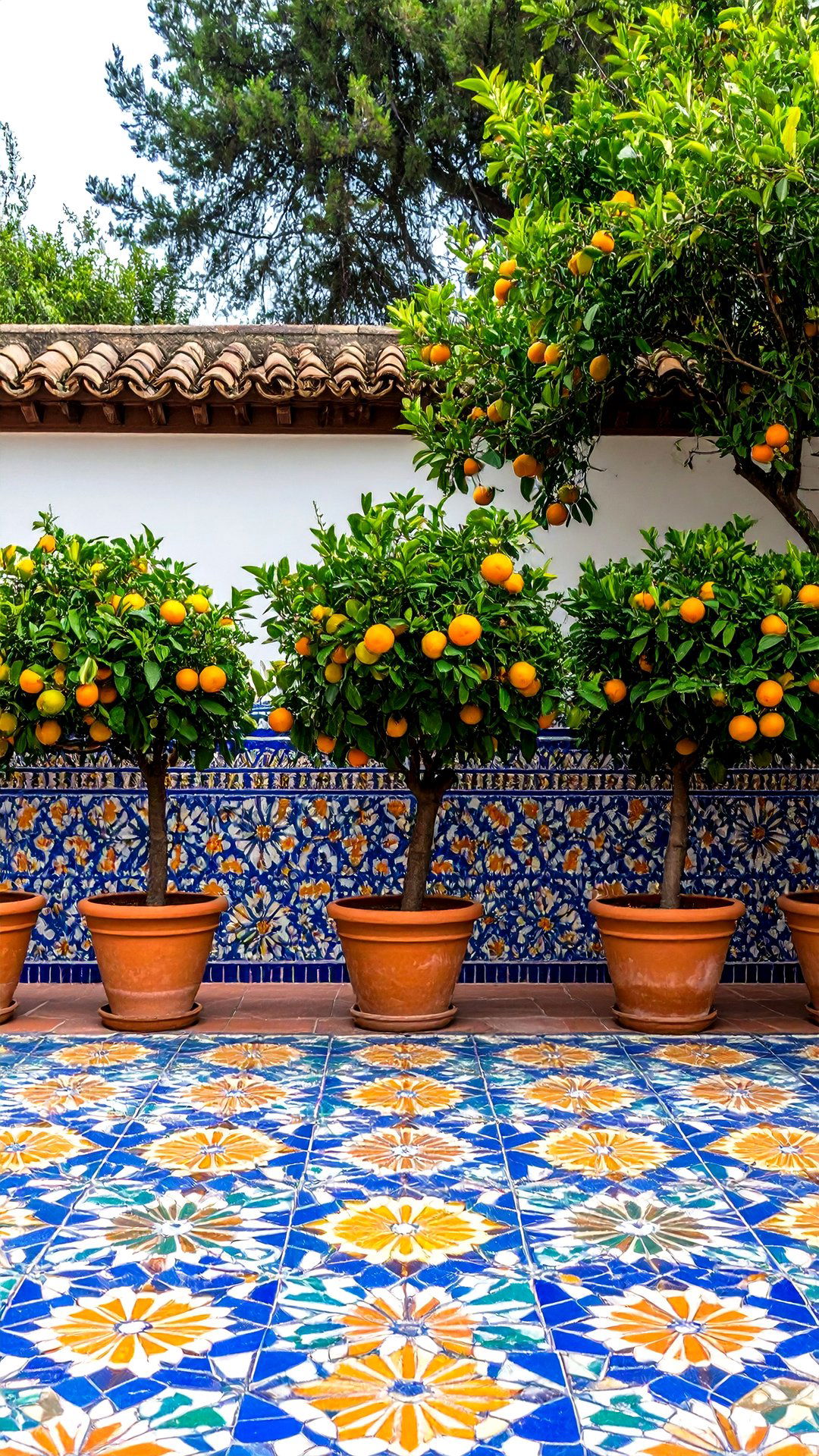
For Mediterranean punch, mosaic tiles set into a rendered garden wall deliver jewel-bright accents that withstand weather. The Stucco Guy emphasizes that thin-set masonry adhesive plus polymer-modified grout resists freeze-thaw better than interior products. Outline motifs — moroccan stars, citrus slices — in pencil first, then work outward with broken pottery shards or purpose-made zellige. Seal finished sections with breathable silane to repel stains without trapping moisture. A mosaic garden wall doubles as backdrop for container citrus trees, making winter lemons feel like a summer holiday extension.
22. Garden Wall with Folding Bench Storage
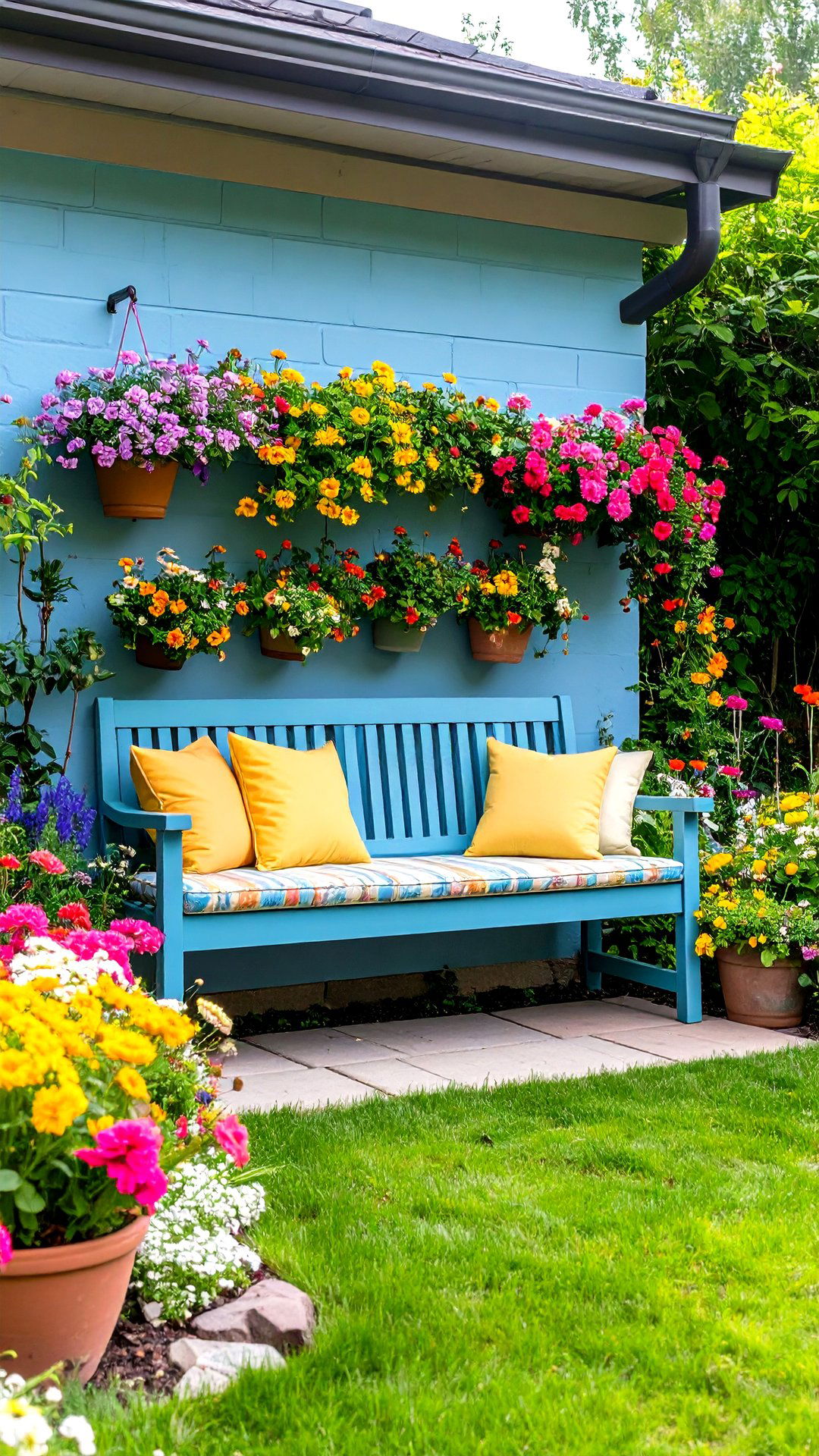
In compact courtyards, a garden wall can hide fold-down seating that disappears when floor space is needed. Homes & Gardens notes designers sinking marine-grade hinges into masonry and cladding seats in hardwood slats for weather resistance. Inside the wall cavity, stainless hooks stow cushions in waterproof bags. Gas struts ease lifting, and magnetic catches stop rattling in wind. Finish the wall in the same paint as the bench for stealth mode, then pull it down at parties — guests will marvel at a boundary that morphs into furniture.
23. Garden Wall Pergola Combo for Shaded Dining
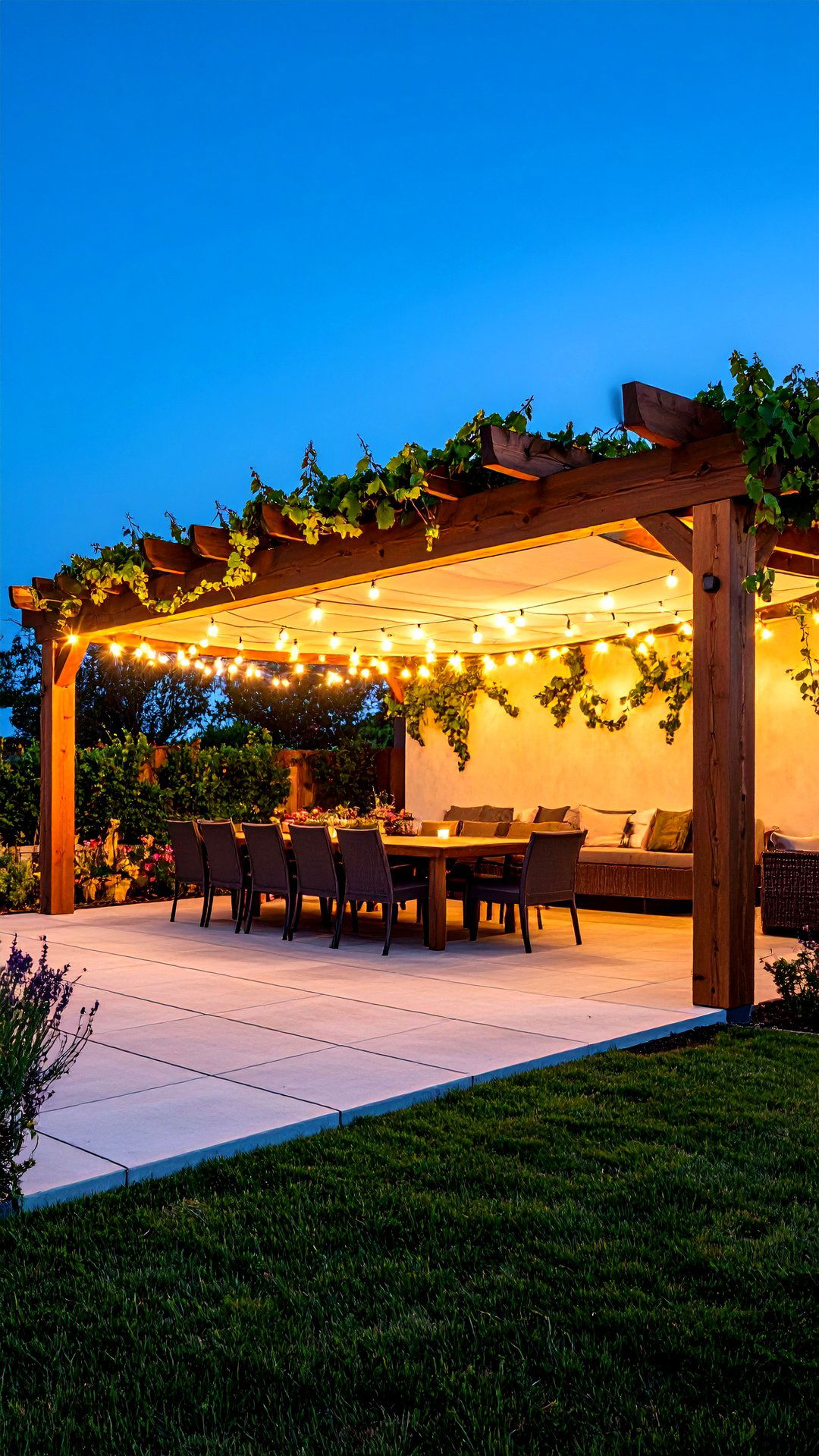
Extending timber rafters out from a sturdy garden wall forms a half-pergola that shades a dining terrace without four hefty posts. Houzz galleries show cedar beams bolted to ledger plates chemically anchored into masonry for strength. Train grapevines or wisteria along stainless wires between rafters, weaving living shade over time. Add a retractable waterproof sail for rainy dinners, and embed LED festoons along the underside for bistro ambience. The wall itself can host a built-in pizza oven, marrying structure, planting, and function into one cohesive backdrop.
24. Recycled Metal Art Garden Wall Panels

Laser-cut recycled steel panels mounted a few centimeters off a block garden wall add depth, pattern, and play of shadow. Container Water Gardens’ corten examples show how abstract leaf or wave cutouts catch sunset light dramatically. Powder-coat aluminum versions offer lighter weight and unlimited color. Hidden spacers create a “floating” effect, and swapping panels seasonally refreshes the look without heavy construction. Combine several panel widths for rhythm, and plant monochrome borders beneath so intricate shadows dance across foliage at dawn and dusk.
25. Garden Wall with Smart Irrigation and Lighting Tech
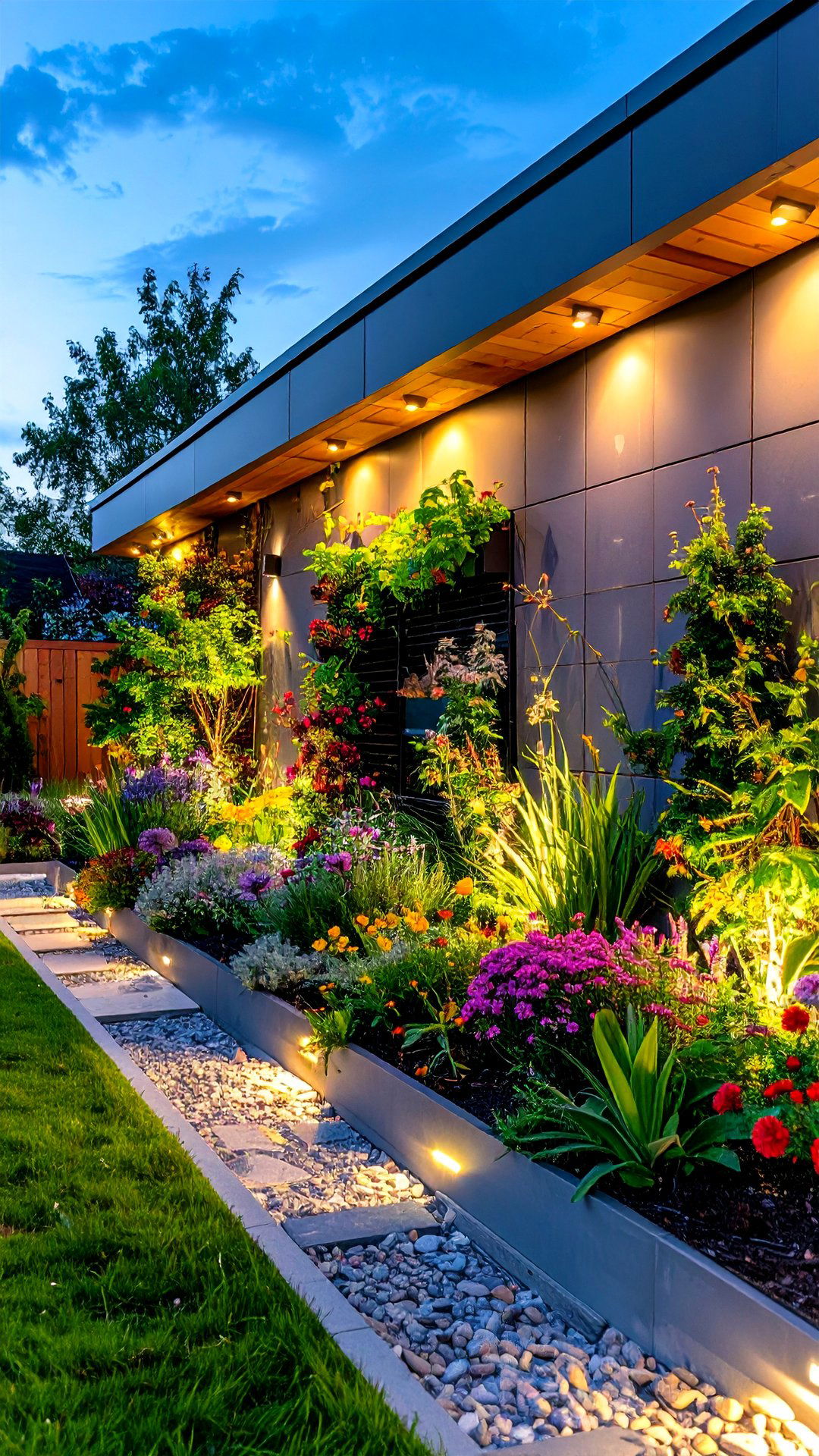
The ultimate future-proof garden wall integrates low-voltage cabling and drip lines before cladding goes on. fixtures sync with app-controlled transformers, letting you schedule uplights or color-change routines for events. Inline solenoid valves in the drip network tie into weather-responsive controllers, so living wall pockets never dry yet won’t waste water after rainfall. Run spare conduits for potential sensor upgrades — temperature, moisture, motion — so the garden wall evolves with tech advances. Finish access panels flush with the cladding to keep aesthetics sleek while enabling maintenance.
Conclusion:
Whether you crave a whisper-quiet retreat or a show-stopping statement, the right garden wall unlocks fresh ways to organize space, nurture plants, and express personality. Classic bricks, on-trend corten, wildlife havens, and tech-savvy smart walls all demonstrate how boundaries become assets instead of afterthoughts. By matching materials to climate, adding purposeful extras — lighting, seating, water, or habitat — and borrowing inspiration from expert sources, any gardener can turn a simple garden wall into the backbone of a beautiful, resilient outdoor sanctuary.


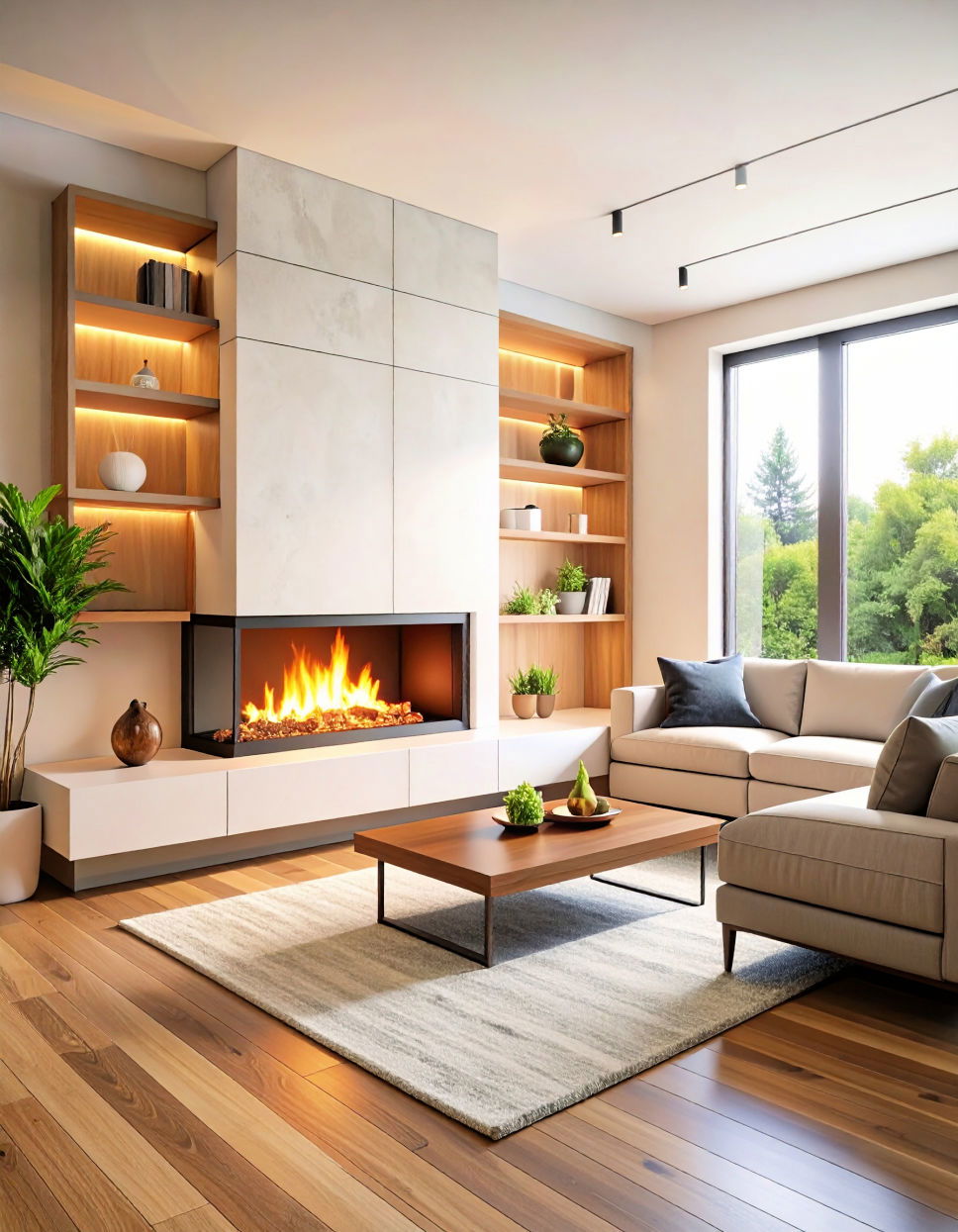

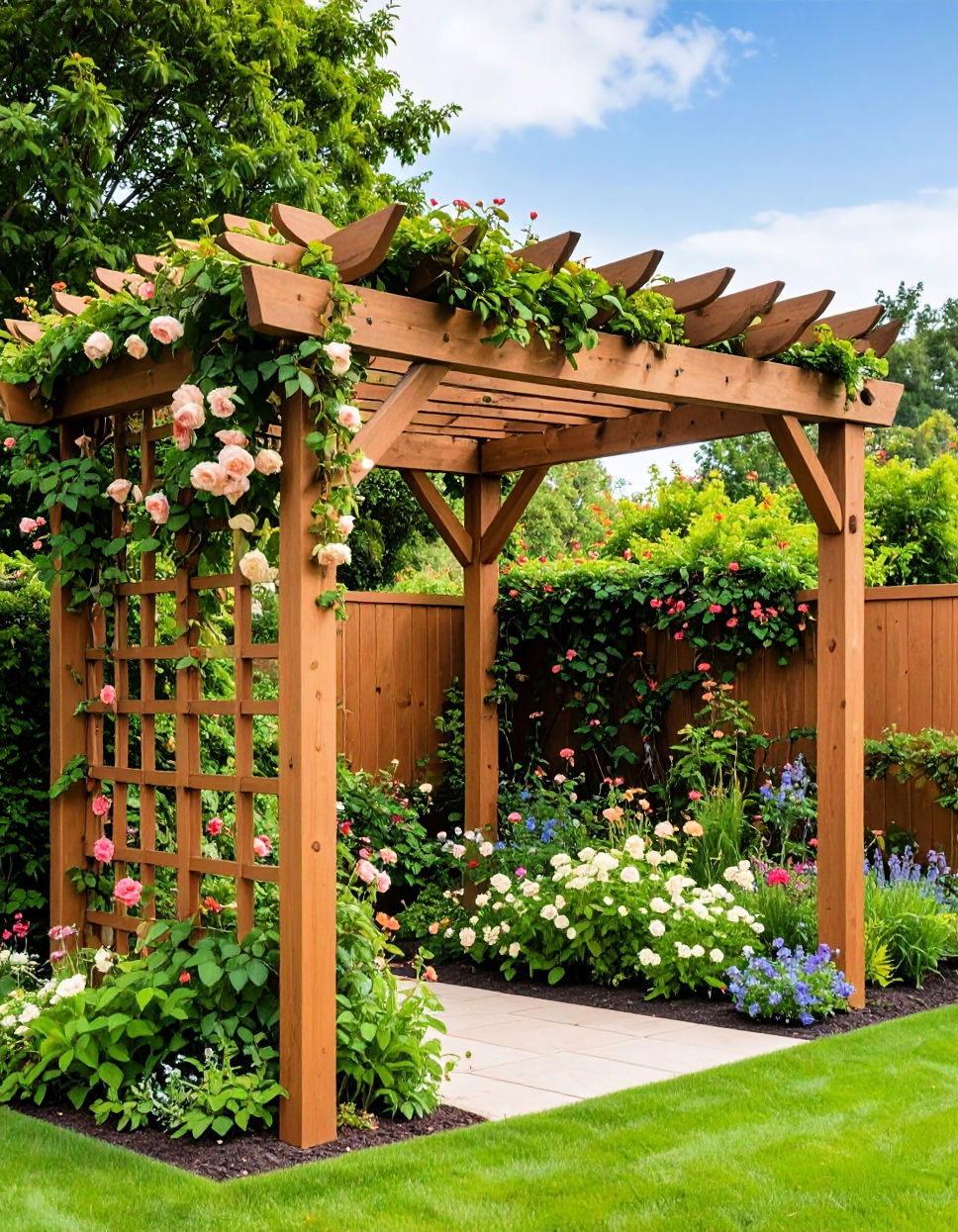
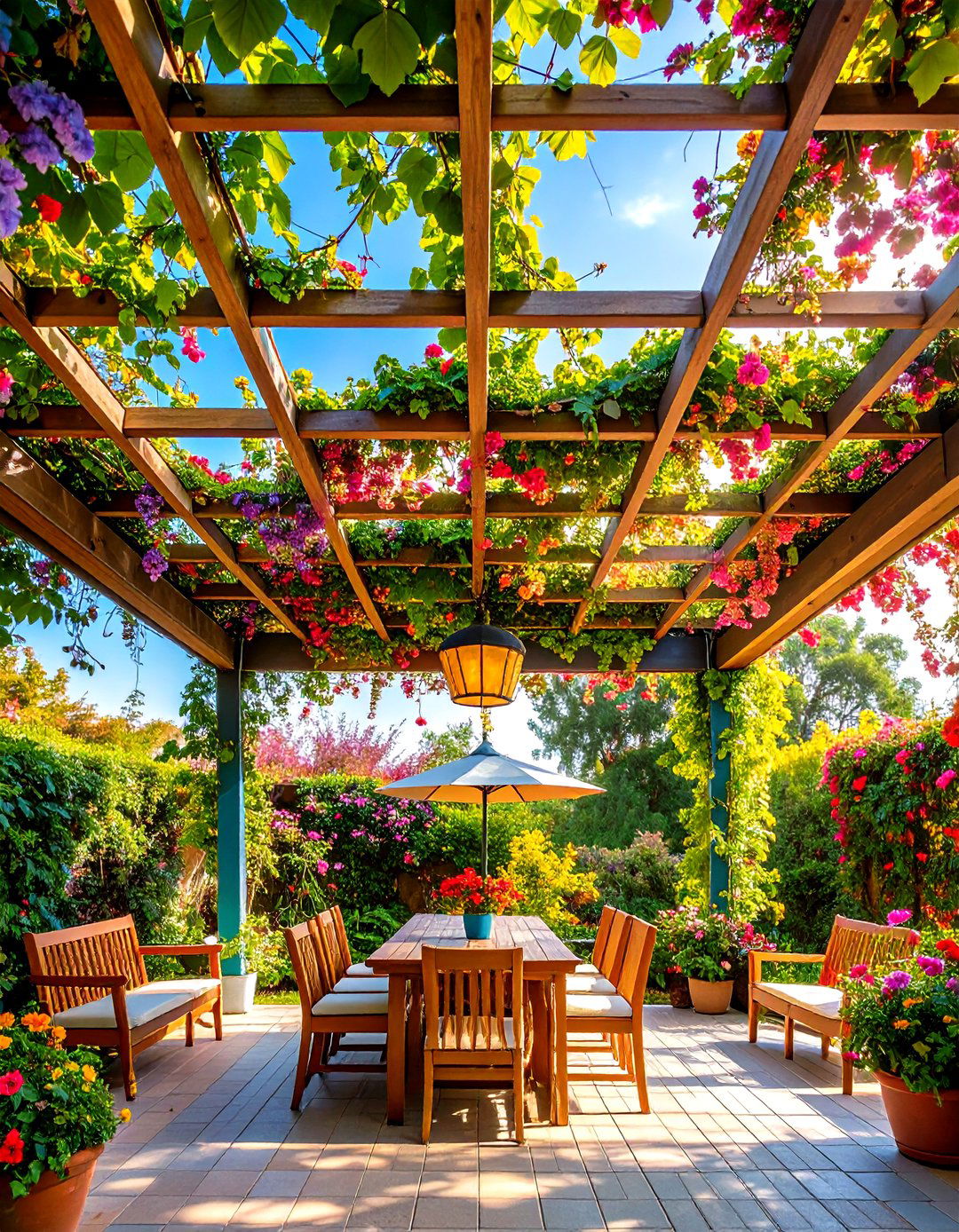
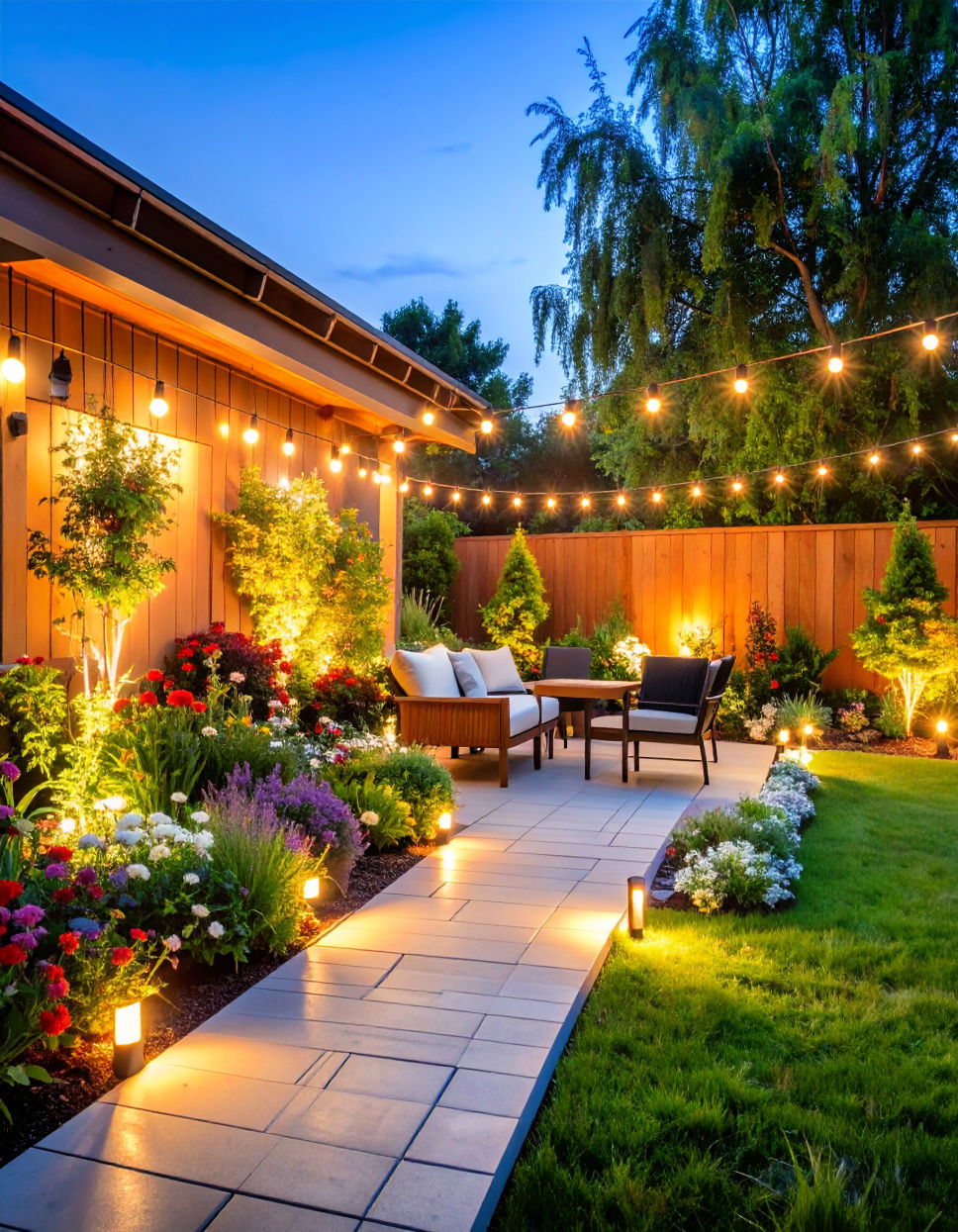


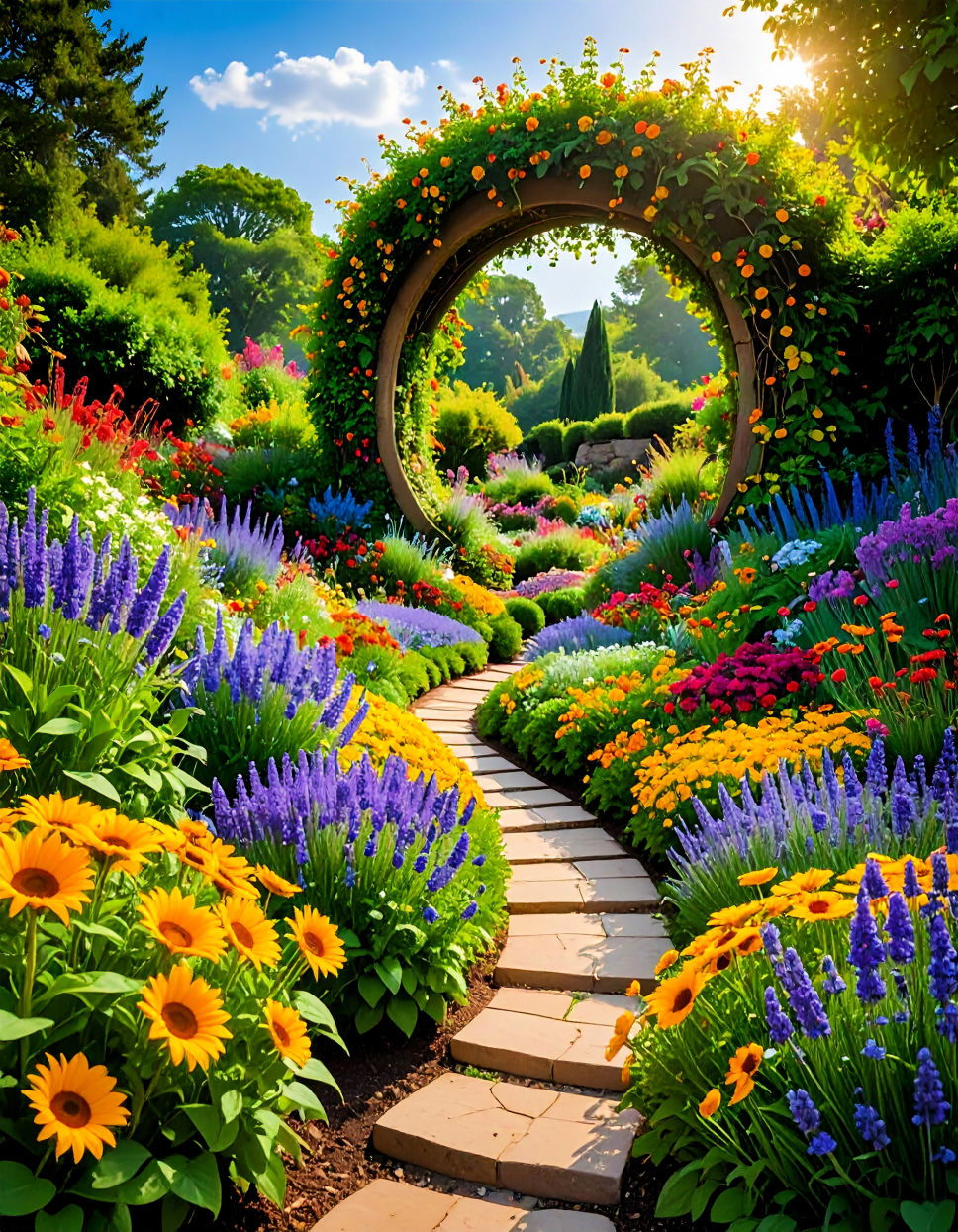
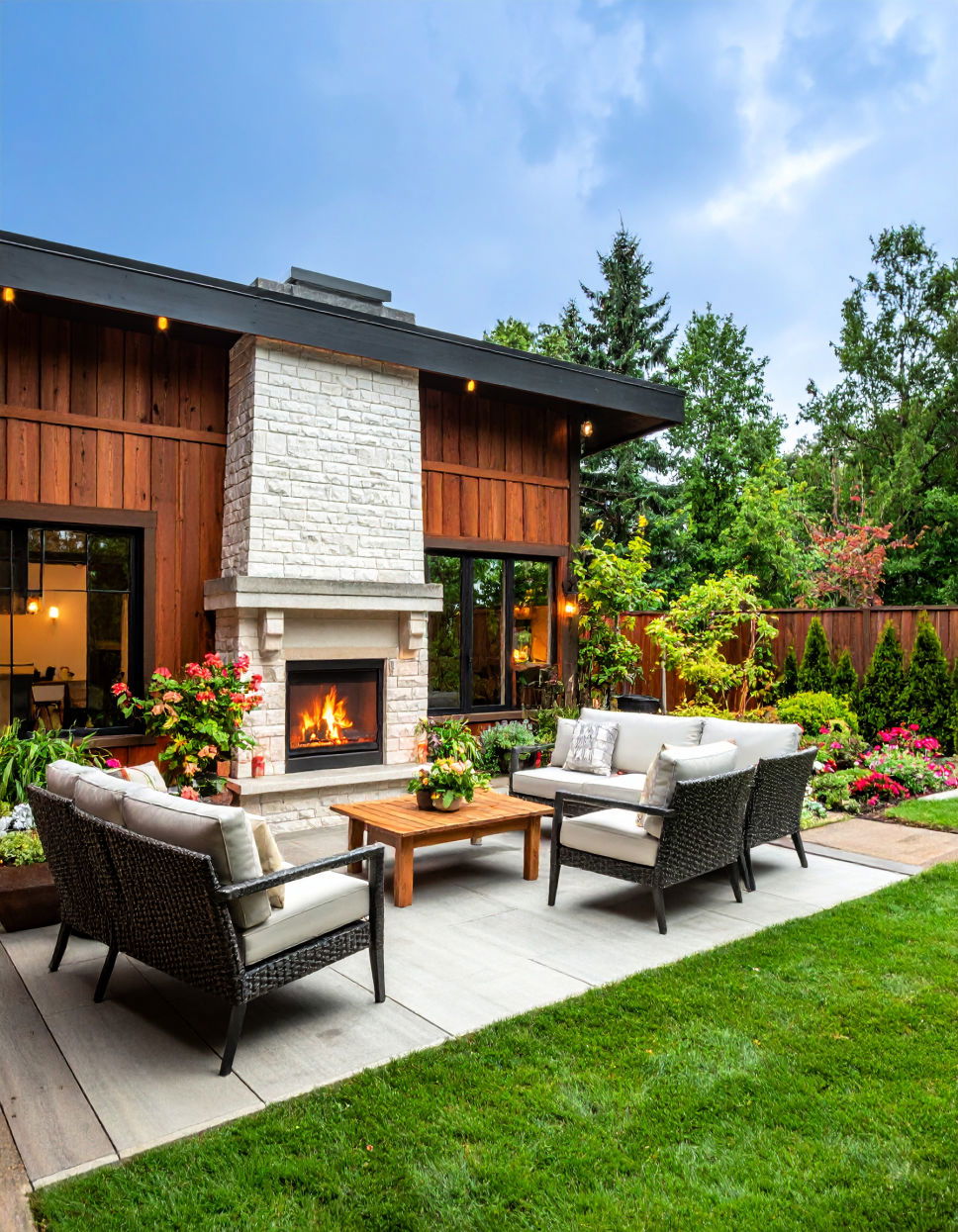

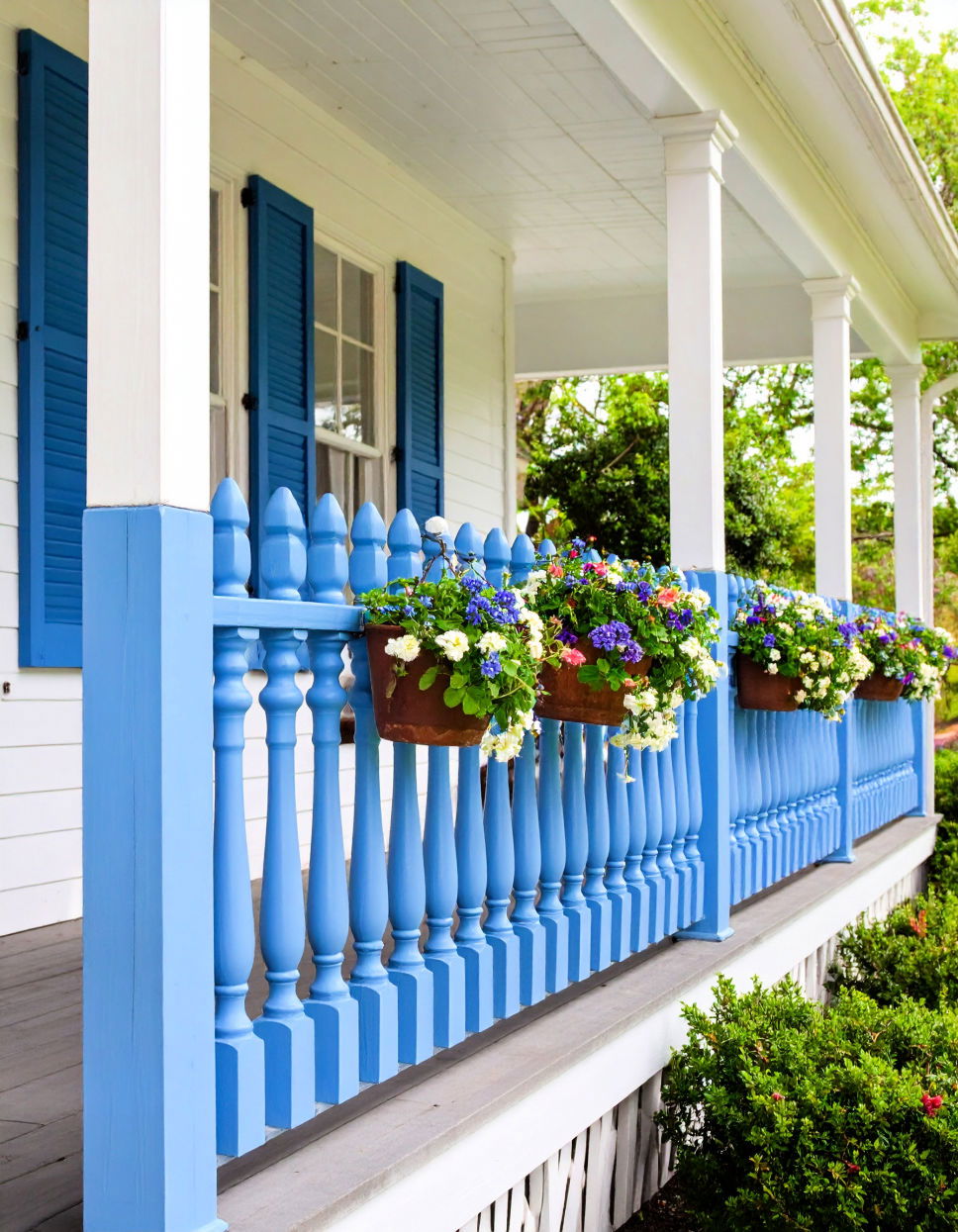
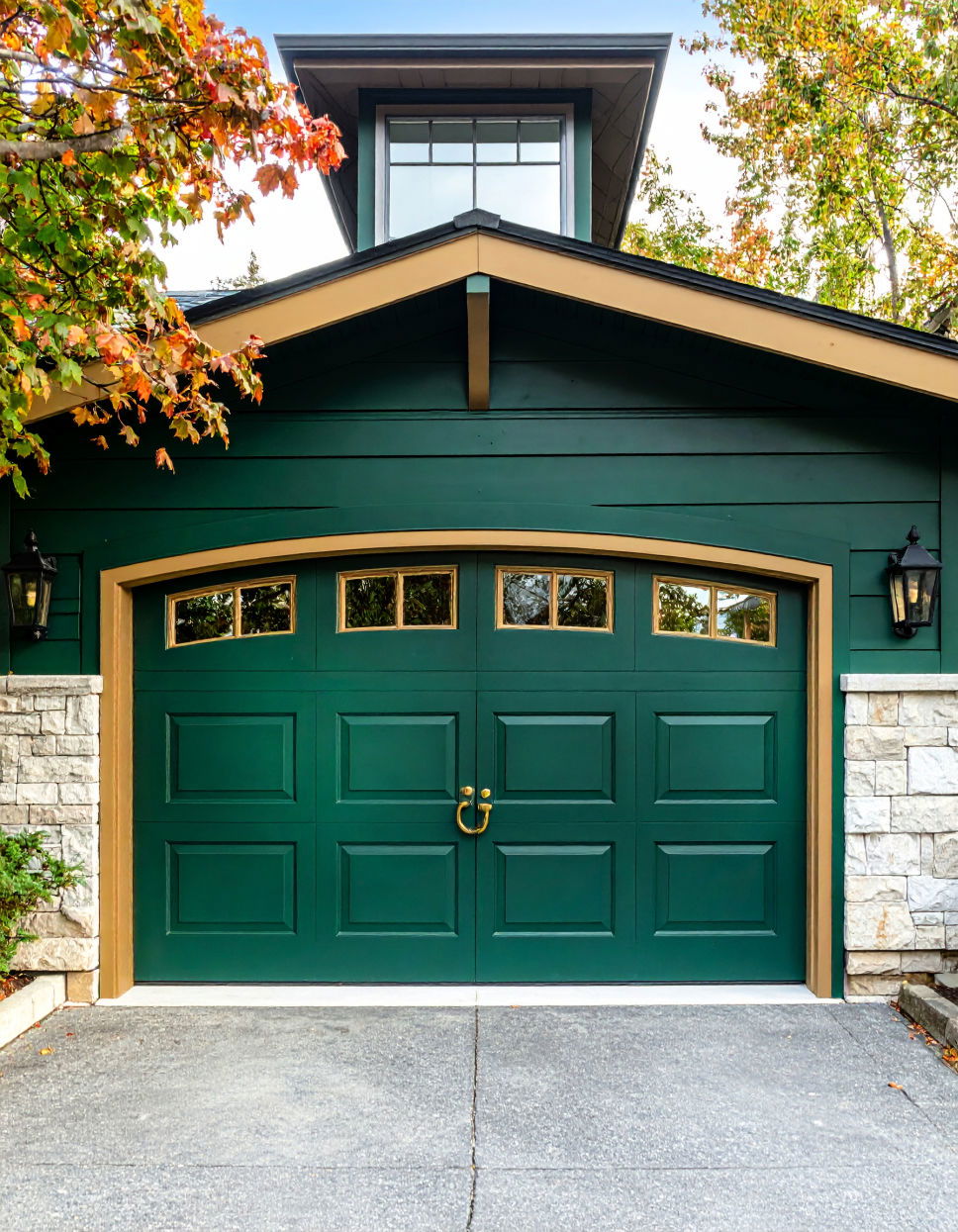
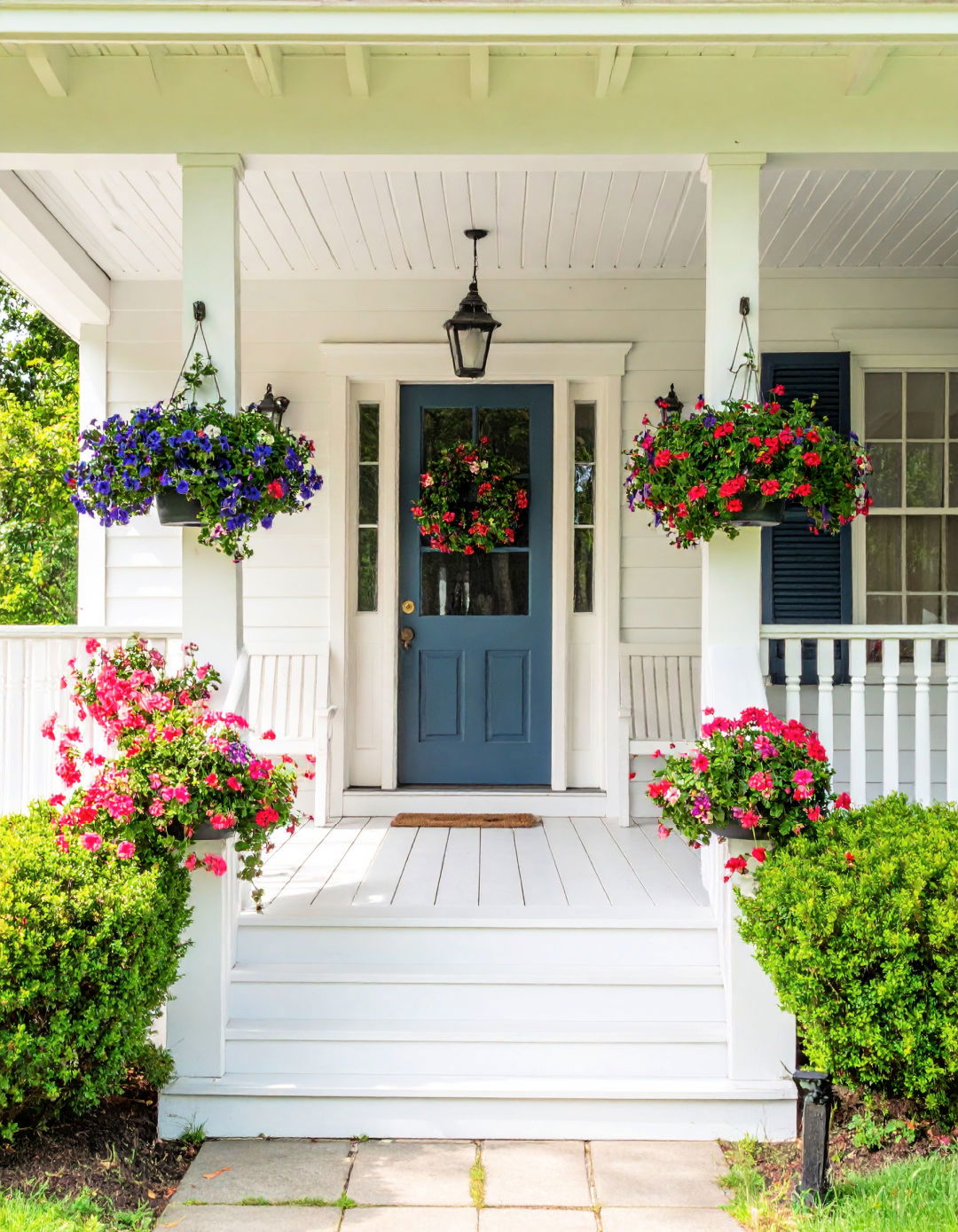
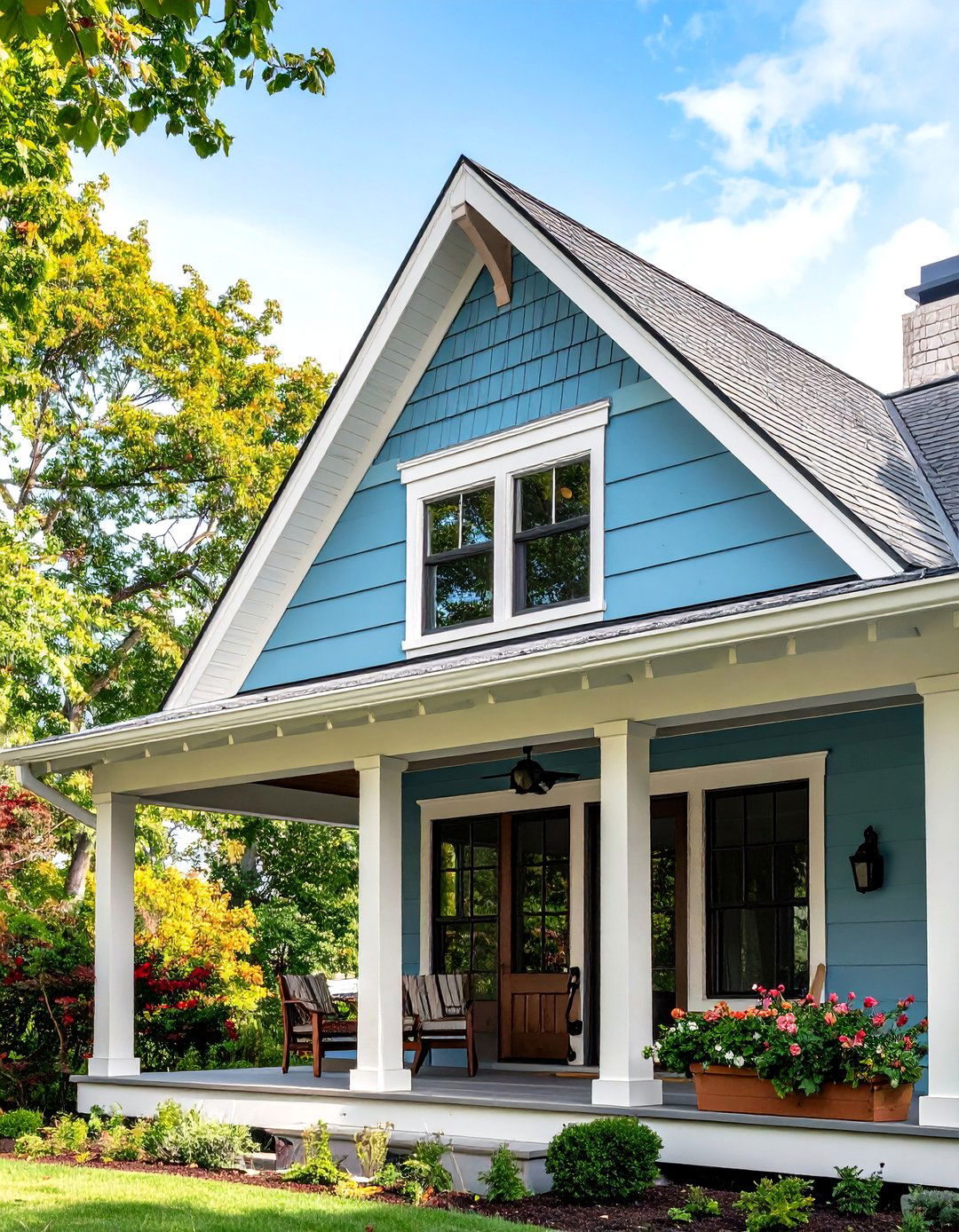
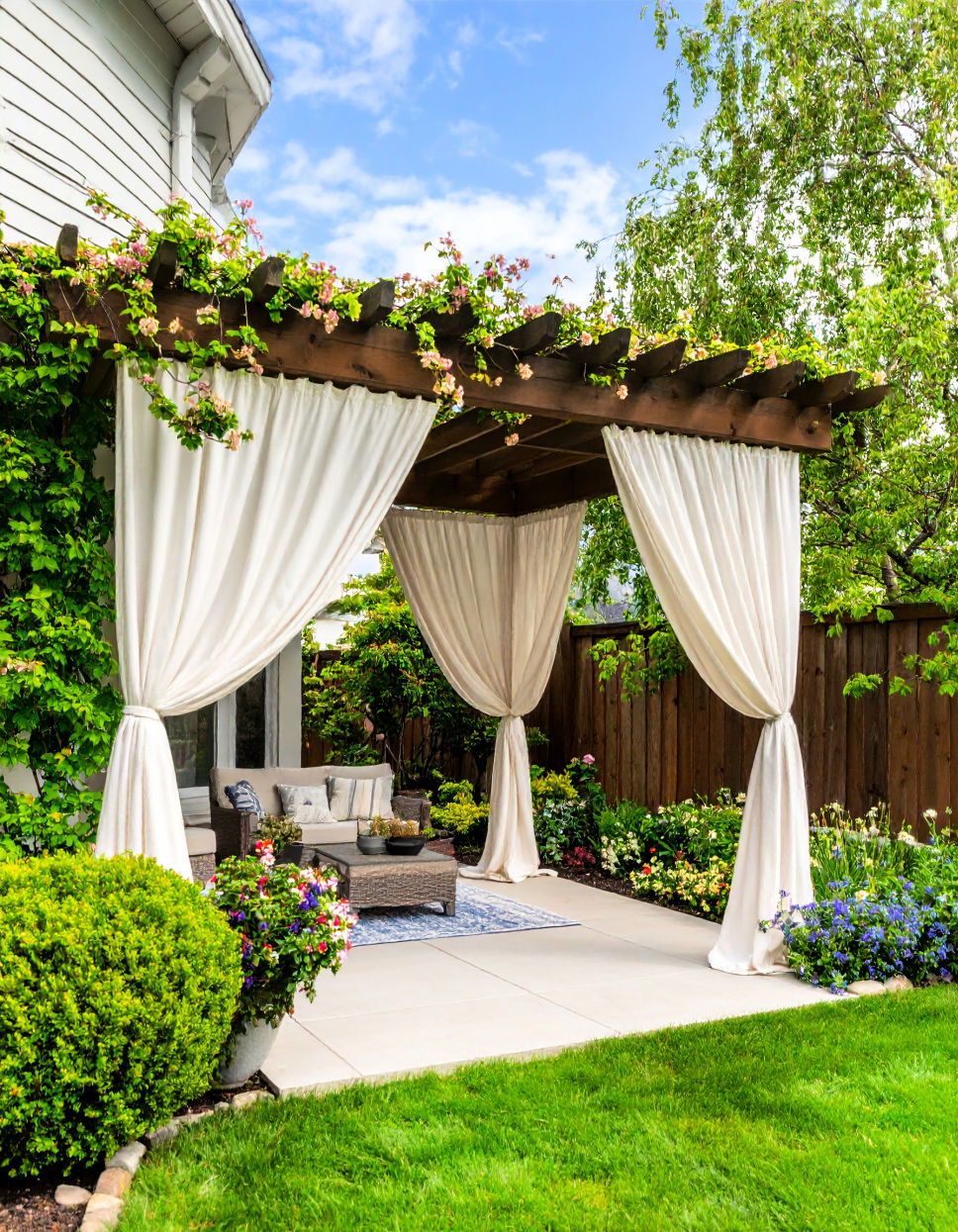
Leave a Reply